Mergers and Acquisition | Assignment
VerifiedAdded on 2022/09/01
|25
|6218
|18
AI Summary
Contribute Materials
Your contribution can guide someone’s learning journey. Share your
documents today.

Mergers and Acquisition
Secure Best Marks with AI Grader
Need help grading? Try our AI Grader for instant feedback on your assignments.
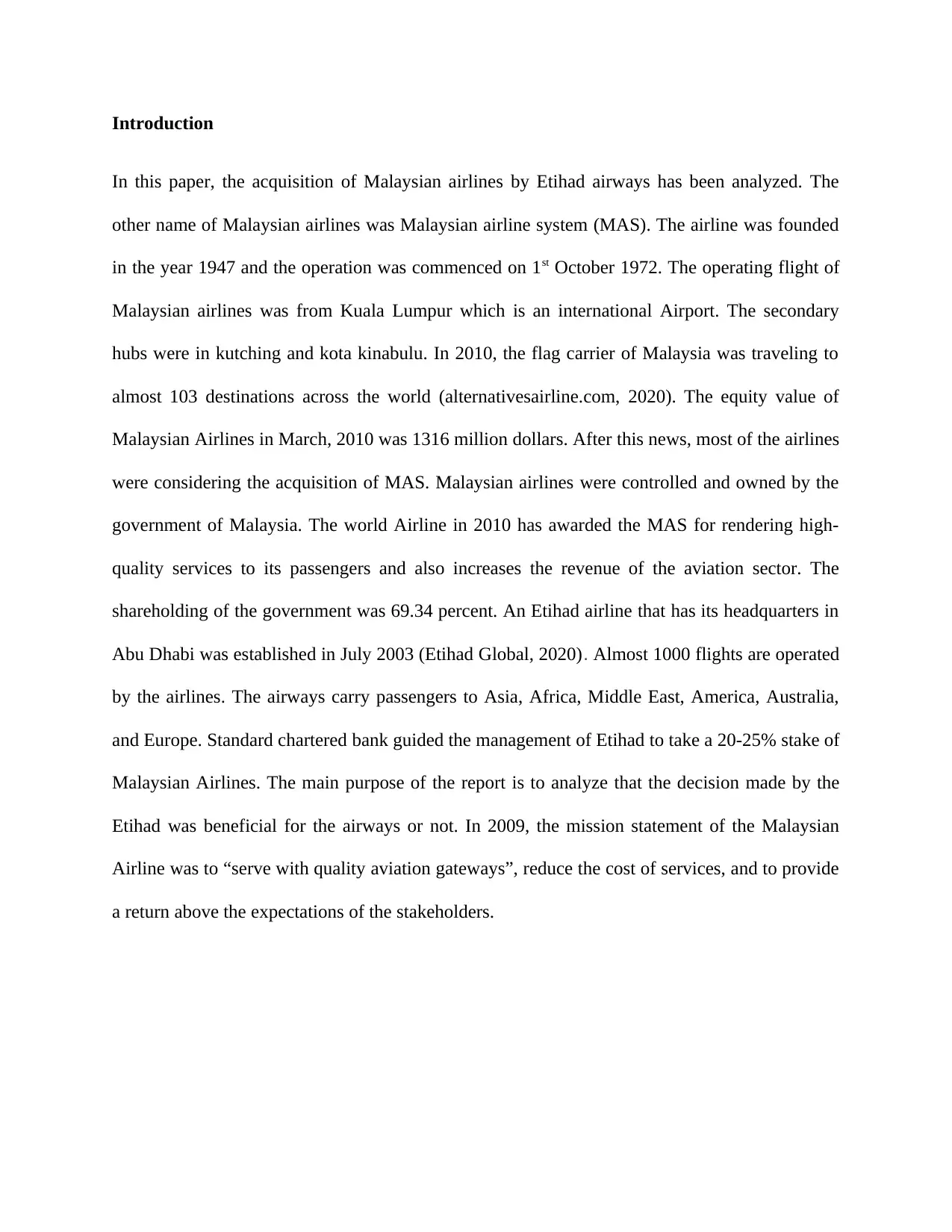
Introduction
In this paper, the acquisition of Malaysian airlines by Etihad airways has been analyzed. The
other name of Malaysian airlines was Malaysian airline system (MAS). The airline was founded
in the year 1947 and the operation was commenced on 1st October 1972. The operating flight of
Malaysian airlines was from Kuala Lumpur which is an international Airport. The secondary
hubs were in kutching and kota kinabulu. In 2010, the flag carrier of Malaysia was traveling to
almost 103 destinations across the world (alternativesairline.com, 2020). The equity value of
Malaysian Airlines in March, 2010 was 1316 million dollars. After this news, most of the airlines
were considering the acquisition of MAS. Malaysian airlines were controlled and owned by the
government of Malaysia. The world Airline in 2010 has awarded the MAS for rendering high-
quality services to its passengers and also increases the revenue of the aviation sector. The
shareholding of the government was 69.34 percent. An Etihad airline that has its headquarters in
Abu Dhabi was established in July 2003 (Etihad Global, 2020). Almost 1000 flights are operated
by the airlines. The airways carry passengers to Asia, Africa, Middle East, America, Australia,
and Europe. Standard chartered bank guided the management of Etihad to take a 20-25% stake of
Malaysian Airlines. The main purpose of the report is to analyze that the decision made by the
Etihad was beneficial for the airways or not. In 2009, the mission statement of the Malaysian
Airline was to “serve with quality aviation gateways”, reduce the cost of services, and to provide
a return above the expectations of the stakeholders.
In this paper, the acquisition of Malaysian airlines by Etihad airways has been analyzed. The
other name of Malaysian airlines was Malaysian airline system (MAS). The airline was founded
in the year 1947 and the operation was commenced on 1st October 1972. The operating flight of
Malaysian airlines was from Kuala Lumpur which is an international Airport. The secondary
hubs were in kutching and kota kinabulu. In 2010, the flag carrier of Malaysia was traveling to
almost 103 destinations across the world (alternativesairline.com, 2020). The equity value of
Malaysian Airlines in March, 2010 was 1316 million dollars. After this news, most of the airlines
were considering the acquisition of MAS. Malaysian airlines were controlled and owned by the
government of Malaysia. The world Airline in 2010 has awarded the MAS for rendering high-
quality services to its passengers and also increases the revenue of the aviation sector. The
shareholding of the government was 69.34 percent. An Etihad airline that has its headquarters in
Abu Dhabi was established in July 2003 (Etihad Global, 2020). Almost 1000 flights are operated
by the airlines. The airways carry passengers to Asia, Africa, Middle East, America, Australia,
and Europe. Standard chartered bank guided the management of Etihad to take a 20-25% stake of
Malaysian Airlines. The main purpose of the report is to analyze that the decision made by the
Etihad was beneficial for the airways or not. In 2009, the mission statement of the Malaysian
Airline was to “serve with quality aviation gateways”, reduce the cost of services, and to provide
a return above the expectations of the stakeholders.

The main issues that are to be considered are:
A) How both the Malaysian airlines and Etihad airlines are similar and whether it will
be advantageous to acquire the stake of the MAS.
B) How are the purchase consideration (fair value) of the target firm (MAS) has been
derived
C) What benefits would be gained by Etihad after the cross border acquisition with
Malaysian airlines
The Similarity between Etihad and MAS
The operation of MAS is only limited to only 5 destinations in Europe but the Etihad airways
serve more than seventeenth (17th) destinations. In Africa and America, there are no destinations
of MAS and only two destinations are served by Malaysian airlines in the middle east that is
Jeddah and Dubai(CAPA – Centre for aviation, 2014). MAS in 2013, was planning to enter into
a partnership with other countries also so that they can expand their aviation business and also
can improve the performance of the flight from Kuala Lumpur to Dubai. MAS were certain that
the local traffic was not reliable for Dubai and was also not viable. The other option for MAS
was Abu Dhabi and that’s the reason they want to tie up with the airlines of Etihad. The Abu
Dhabi hub of Etihad operates in 15 destinations that were within Kuala Lumpur to Abu Dhabi
and in the Middle East. The current codeshare of Etihad to Malaysian airlines is limited only to
Muscat, Kuwait, and Bahrain. The trade between the Middle East and Asia will be enhanced.
Fair value computation method
It is the value of total liabilities and assets of any company which is listed on the books of the
company. According to Szücs and Ulbert (2017, p-51), fair value is the potential price of any
A) How both the Malaysian airlines and Etihad airlines are similar and whether it will
be advantageous to acquire the stake of the MAS.
B) How are the purchase consideration (fair value) of the target firm (MAS) has been
derived
C) What benefits would be gained by Etihad after the cross border acquisition with
Malaysian airlines
The Similarity between Etihad and MAS
The operation of MAS is only limited to only 5 destinations in Europe but the Etihad airways
serve more than seventeenth (17th) destinations. In Africa and America, there are no destinations
of MAS and only two destinations are served by Malaysian airlines in the middle east that is
Jeddah and Dubai(CAPA – Centre for aviation, 2014). MAS in 2013, was planning to enter into
a partnership with other countries also so that they can expand their aviation business and also
can improve the performance of the flight from Kuala Lumpur to Dubai. MAS were certain that
the local traffic was not reliable for Dubai and was also not viable. The other option for MAS
was Abu Dhabi and that’s the reason they want to tie up with the airlines of Etihad. The Abu
Dhabi hub of Etihad operates in 15 destinations that were within Kuala Lumpur to Abu Dhabi
and in the Middle East. The current codeshare of Etihad to Malaysian airlines is limited only to
Muscat, Kuwait, and Bahrain. The trade between the Middle East and Asia will be enhanced.
Fair value computation method
It is the value of total liabilities and assets of any company which is listed on the books of the
company. According to Szücs and Ulbert (2017, p-51), fair value is the potential price of any
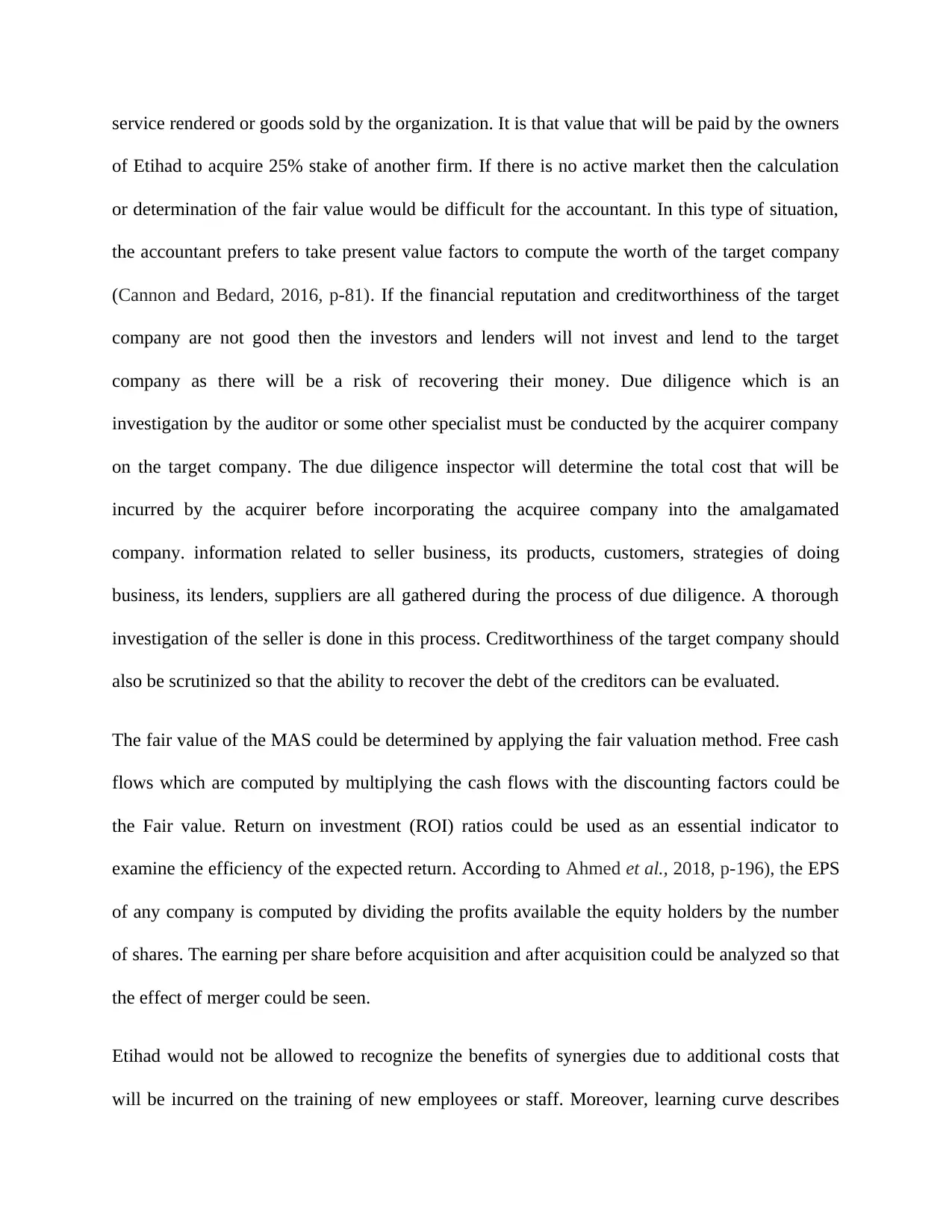
service rendered or goods sold by the organization. It is that value that will be paid by the owners
of Etihad to acquire 25% stake of another firm. If there is no active market then the calculation
or determination of the fair value would be difficult for the accountant. In this type of situation,
the accountant prefers to take present value factors to compute the worth of the target company
(Cannon and Bedard, 2016, p-81). If the financial reputation and creditworthiness of the target
company are not good then the investors and lenders will not invest and lend to the target
company as there will be a risk of recovering their money. Due diligence which is an
investigation by the auditor or some other specialist must be conducted by the acquirer company
on the target company. The due diligence inspector will determine the total cost that will be
incurred by the acquirer before incorporating the acquiree company into the amalgamated
company. information related to seller business, its products, customers, strategies of doing
business, its lenders, suppliers are all gathered during the process of due diligence. A thorough
investigation of the seller is done in this process. Creditworthiness of the target company should
also be scrutinized so that the ability to recover the debt of the creditors can be evaluated.
The fair value of the MAS could be determined by applying the fair valuation method. Free cash
flows which are computed by multiplying the cash flows with the discounting factors could be
the Fair value. Return on investment (ROI) ratios could be used as an essential indicator to
examine the efficiency of the expected return. According to Ahmed et al., 2018, p-196), the EPS
of any company is computed by dividing the profits available the equity holders by the number
of shares. The earning per share before acquisition and after acquisition could be analyzed so that
the effect of merger could be seen.
Etihad would not be allowed to recognize the benefits of synergies due to additional costs that
will be incurred on the training of new employees or staff. Moreover, learning curve describes
of Etihad to acquire 25% stake of another firm. If there is no active market then the calculation
or determination of the fair value would be difficult for the accountant. In this type of situation,
the accountant prefers to take present value factors to compute the worth of the target company
(Cannon and Bedard, 2016, p-81). If the financial reputation and creditworthiness of the target
company are not good then the investors and lenders will not invest and lend to the target
company as there will be a risk of recovering their money. Due diligence which is an
investigation by the auditor or some other specialist must be conducted by the acquirer company
on the target company. The due diligence inspector will determine the total cost that will be
incurred by the acquirer before incorporating the acquiree company into the amalgamated
company. information related to seller business, its products, customers, strategies of doing
business, its lenders, suppliers are all gathered during the process of due diligence. A thorough
investigation of the seller is done in this process. Creditworthiness of the target company should
also be scrutinized so that the ability to recover the debt of the creditors can be evaluated.
The fair value of the MAS could be determined by applying the fair valuation method. Free cash
flows which are computed by multiplying the cash flows with the discounting factors could be
the Fair value. Return on investment (ROI) ratios could be used as an essential indicator to
examine the efficiency of the expected return. According to Ahmed et al., 2018, p-196), the EPS
of any company is computed by dividing the profits available the equity holders by the number
of shares. The earning per share before acquisition and after acquisition could be analyzed so that
the effect of merger could be seen.
Etihad would not be allowed to recognize the benefits of synergies due to additional costs that
will be incurred on the training of new employees or staff. Moreover, learning curve describes
Secure Best Marks with AI Grader
Need help grading? Try our AI Grader for instant feedback on your assignments.

that new employees take time to adjust themselves to new situation. After the payment of the
purchase consideration to MAS if the amount results in goodwill then it signifies that Etihad has
paid extras amount to purchase the stake and if it results in capital reserve then it means that
assets and liabilities have been acquired at an amount less than the book value of the target
company.
Strategic advantages
The Etihad airlines would be able to reduce the direct and indirect cost by implementing new
methods of Malaysian airlines and also by implementing the technology of MAS. The handling
services, cargo, and frequent fliers of MAS will also be added by the administration department
of Etihad. The agreement of code sharing will also be profitable for the Etihad airlines as they
would be operating for the Etihad as a hub. The marketing cost will also be reduced by entering
into a new market. The other benefits are that the major portions of the holding of Malaysian
airlines are held by the Malaysian government so Etihad will get full government support.
Portfolio risk will be reduced as the MAS are diversified in various market segments. Route such
as Malaysia to Thailand is the most favorable brand for passengers. The organizational structure
of the MAS is very simple and strong. The attractive airline scheme helps to expand the revenue
of medical tourism. The CSR responsibilities will be increased as the MAS are very active in
CSR activities. By doing bilateral agreement the aviation market will be highly regulated. The
mergers will also result in operating and financial synergy. Various advantages of the diversified
firm (MAS) can be explored by Etihad. The financial synergy such as debt capacity, profitability,
revenue, and cost of capital will be improved to a huge extent. The cost will be decreased
through the assistance of streamline operation
purchase consideration to MAS if the amount results in goodwill then it signifies that Etihad has
paid extras amount to purchase the stake and if it results in capital reserve then it means that
assets and liabilities have been acquired at an amount less than the book value of the target
company.
Strategic advantages
The Etihad airlines would be able to reduce the direct and indirect cost by implementing new
methods of Malaysian airlines and also by implementing the technology of MAS. The handling
services, cargo, and frequent fliers of MAS will also be added by the administration department
of Etihad. The agreement of code sharing will also be profitable for the Etihad airlines as they
would be operating for the Etihad as a hub. The marketing cost will also be reduced by entering
into a new market. The other benefits are that the major portions of the holding of Malaysian
airlines are held by the Malaysian government so Etihad will get full government support.
Portfolio risk will be reduced as the MAS are diversified in various market segments. Route such
as Malaysia to Thailand is the most favorable brand for passengers. The organizational structure
of the MAS is very simple and strong. The attractive airline scheme helps to expand the revenue
of medical tourism. The CSR responsibilities will be increased as the MAS are very active in
CSR activities. By doing bilateral agreement the aviation market will be highly regulated. The
mergers will also result in operating and financial synergy. Various advantages of the diversified
firm (MAS) can be explored by Etihad. The financial synergy such as debt capacity, profitability,
revenue, and cost of capital will be improved to a huge extent. The cost will be decreased
through the assistance of streamline operation

The other advantages of financial synergy:
Ability to pay the debt will be increase
High amount of cash flows will be generated
The capital cost will be reduced
Benefit of taxes
If there is positive synergy then the result will be successful (Kiesel et al., 2017, p-781).
Sometimes due to the high cost incurred by the acquirer on developing the target
company, the synergy would be negative (Manuela Jr. et al., 2016, p-138).
If there are low financing costs and the capital structure then Etihad will acquire the
business by paying a high amount of premium to the MAS.
According to Ogada et al., 2016, p-51), operating synergy arises when the combine’s
value of the new firm is higher than the value of separate firms and which led to
achieving a high rate of growth and also the operating income increases.
Benefits arise from operating synergies are:
Due to lower competition and increases in the market share, Etihad will enjoy higher
margin as well as a greater margin of pricing power (Uhlenbruck et al., 2017, p-40)
Product lines and marketing skills will improve after the combination
Market will be expanding and the growth level will also get increased.
The economies of scale will be highly network-based.
Ability to pay the debt will be increase
High amount of cash flows will be generated
The capital cost will be reduced
Benefit of taxes
If there is positive synergy then the result will be successful (Kiesel et al., 2017, p-781).
Sometimes due to the high cost incurred by the acquirer on developing the target
company, the synergy would be negative (Manuela Jr. et al., 2016, p-138).
If there are low financing costs and the capital structure then Etihad will acquire the
business by paying a high amount of premium to the MAS.
According to Ogada et al., 2016, p-51), operating synergy arises when the combine’s
value of the new firm is higher than the value of separate firms and which led to
achieving a high rate of growth and also the operating income increases.
Benefits arise from operating synergies are:
Due to lower competition and increases in the market share, Etihad will enjoy higher
margin as well as a greater margin of pricing power (Uhlenbruck et al., 2017, p-40)
Product lines and marketing skills will improve after the combination
Market will be expanding and the growth level will also get increased.
The economies of scale will be highly network-based.
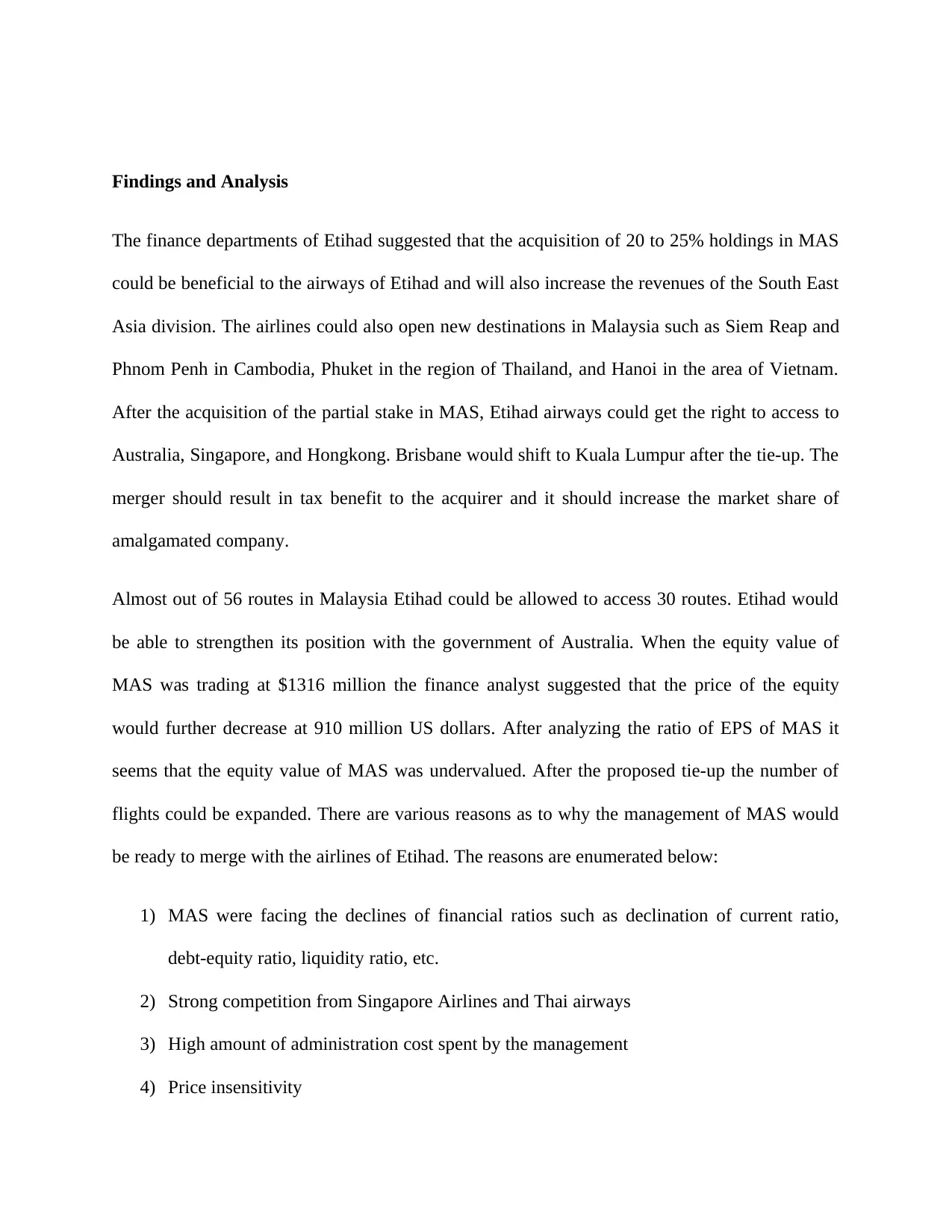
Findings and Analysis
The finance departments of Etihad suggested that the acquisition of 20 to 25% holdings in MAS
could be beneficial to the airways of Etihad and will also increase the revenues of the South East
Asia division. The airlines could also open new destinations in Malaysia such as Siem Reap and
Phnom Penh in Cambodia, Phuket in the region of Thailand, and Hanoi in the area of Vietnam.
After the acquisition of the partial stake in MAS, Etihad airways could get the right to access to
Australia, Singapore, and Hongkong. Brisbane would shift to Kuala Lumpur after the tie-up. The
merger should result in tax benefit to the acquirer and it should increase the market share of
amalgamated company.
Almost out of 56 routes in Malaysia Etihad could be allowed to access 30 routes. Etihad would
be able to strengthen its position with the government of Australia. When the equity value of
MAS was trading at $1316 million the finance analyst suggested that the price of the equity
would further decrease at 910 million US dollars. After analyzing the ratio of EPS of MAS it
seems that the equity value of MAS was undervalued. After the proposed tie-up the number of
flights could be expanded. There are various reasons as to why the management of MAS would
be ready to merge with the airlines of Etihad. The reasons are enumerated below:
1) MAS were facing the declines of financial ratios such as declination of current ratio,
debt-equity ratio, liquidity ratio, etc.
2) Strong competition from Singapore Airlines and Thai airways
3) High amount of administration cost spent by the management
4) Price insensitivity
The finance departments of Etihad suggested that the acquisition of 20 to 25% holdings in MAS
could be beneficial to the airways of Etihad and will also increase the revenues of the South East
Asia division. The airlines could also open new destinations in Malaysia such as Siem Reap and
Phnom Penh in Cambodia, Phuket in the region of Thailand, and Hanoi in the area of Vietnam.
After the acquisition of the partial stake in MAS, Etihad airways could get the right to access to
Australia, Singapore, and Hongkong. Brisbane would shift to Kuala Lumpur after the tie-up. The
merger should result in tax benefit to the acquirer and it should increase the market share of
amalgamated company.
Almost out of 56 routes in Malaysia Etihad could be allowed to access 30 routes. Etihad would
be able to strengthen its position with the government of Australia. When the equity value of
MAS was trading at $1316 million the finance analyst suggested that the price of the equity
would further decrease at 910 million US dollars. After analyzing the ratio of EPS of MAS it
seems that the equity value of MAS was undervalued. After the proposed tie-up the number of
flights could be expanded. There are various reasons as to why the management of MAS would
be ready to merge with the airlines of Etihad. The reasons are enumerated below:
1) MAS were facing the declines of financial ratios such as declination of current ratio,
debt-equity ratio, liquidity ratio, etc.
2) Strong competition from Singapore Airlines and Thai airways
3) High amount of administration cost spent by the management
4) Price insensitivity
Paraphrase This Document
Need a fresh take? Get an instant paraphrase of this document with our AI Paraphraser

5) The airlines were also facing continuous losses
Market valuation of the acquiree company assists the acquirer company to evaluate the synergies
effect from the merger. According to Duan and Jin (2019, p-60), synergy is the profit that is
derived after the merger or acquisition of the target company. The merged firm value after
merger increases which are known as synergy and there are two types of synergy one is soft
synergy and the other is hard synergy. If the revenue of Etihad after combination increases then
it is known as soft synergies and if there is any cost saving in the administration expenditure then
the synergy is hard (Smeets et al., 2016, p-463).
Malaysia Airlines in 2010 was affected by foreign exchange fluctuation as 80-90% of operation
of the airlines was foreign operation. Almost 59% of the sales of the airlines are denominated in
Japanese yen, euro, pounds, and dollars.
The factors that are to be considered by Etihad for cross border bid
Cross border mergers will only take place when both the acquirer and the acquiree are benefitted
from the agreement of merger. International mergers are one of the common strategies which are
very popular nowadays. It assists the companies to spread or diversified their operations
globally. Many domestic organizations overstate the financial statements and also do window
dressing when any mergers or acquisition is going to be dealt with any foreign company. The
foreign company should also carry out due diligence while dealing with any domestic firm for
any acquisition or merger. They should assign investment banks and management consultancies
doing any agreement with the domestic company. Etihad should also take into consideration risk
Market valuation of the acquiree company assists the acquirer company to evaluate the synergies
effect from the merger. According to Duan and Jin (2019, p-60), synergy is the profit that is
derived after the merger or acquisition of the target company. The merged firm value after
merger increases which are known as synergy and there are two types of synergy one is soft
synergy and the other is hard synergy. If the revenue of Etihad after combination increases then
it is known as soft synergies and if there is any cost saving in the administration expenditure then
the synergy is hard (Smeets et al., 2016, p-463).
Malaysia Airlines in 2010 was affected by foreign exchange fluctuation as 80-90% of operation
of the airlines was foreign operation. Almost 59% of the sales of the airlines are denominated in
Japanese yen, euro, pounds, and dollars.
The factors that are to be considered by Etihad for cross border bid
Cross border mergers will only take place when both the acquirer and the acquiree are benefitted
from the agreement of merger. International mergers are one of the common strategies which are
very popular nowadays. It assists the companies to spread or diversified their operations
globally. Many domestic organizations overstate the financial statements and also do window
dressing when any mergers or acquisition is going to be dealt with any foreign company. The
foreign company should also carry out due diligence while dealing with any domestic firm for
any acquisition or merger. They should assign investment banks and management consultancies
doing any agreement with the domestic company. Etihad should also take into consideration risk
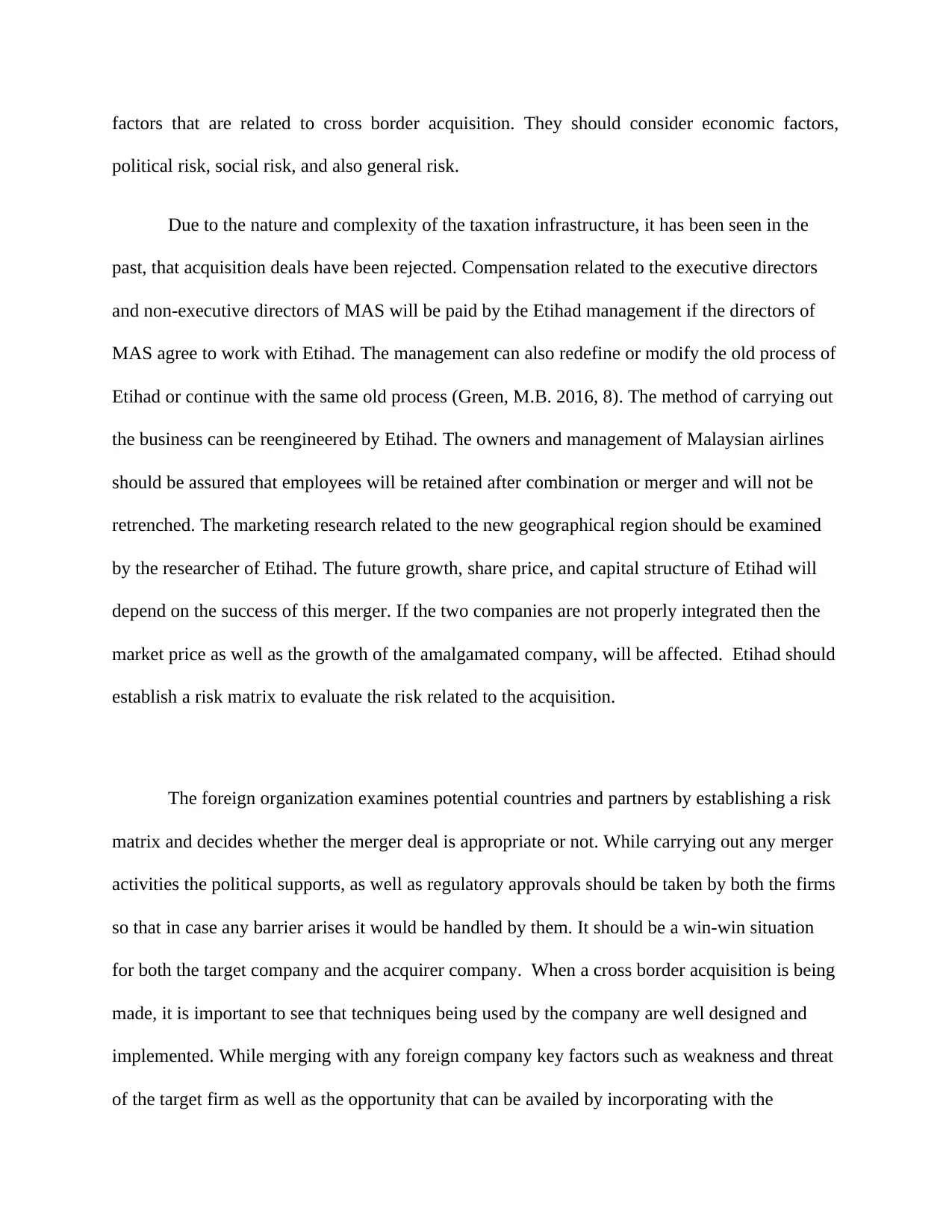
factors that are related to cross border acquisition. They should consider economic factors,
political risk, social risk, and also general risk.
Due to the nature and complexity of the taxation infrastructure, it has been seen in the
past, that acquisition deals have been rejected. Compensation related to the executive directors
and non-executive directors of MAS will be paid by the Etihad management if the directors of
MAS agree to work with Etihad. The management can also redefine or modify the old process of
Etihad or continue with the same old process (Green, M.B. 2016, 8). The method of carrying out
the business can be reengineered by Etihad. The owners and management of Malaysian airlines
should be assured that employees will be retained after combination or merger and will not be
retrenched. The marketing research related to the new geographical region should be examined
by the researcher of Etihad. The future growth, share price, and capital structure of Etihad will
depend on the success of this merger. If the two companies are not properly integrated then the
market price as well as the growth of the amalgamated company, will be affected. Etihad should
establish a risk matrix to evaluate the risk related to the acquisition.
The foreign organization examines potential countries and partners by establishing a risk
matrix and decides whether the merger deal is appropriate or not. While carrying out any merger
activities the political supports, as well as regulatory approvals should be taken by both the firms
so that in case any barrier arises it would be handled by them. It should be a win-win situation
for both the target company and the acquirer company. When a cross border acquisition is being
made, it is important to see that techniques being used by the company are well designed and
implemented. While merging with any foreign company key factors such as weakness and threat
of the target firm as well as the opportunity that can be availed by incorporating with the
political risk, social risk, and also general risk.
Due to the nature and complexity of the taxation infrastructure, it has been seen in the
past, that acquisition deals have been rejected. Compensation related to the executive directors
and non-executive directors of MAS will be paid by the Etihad management if the directors of
MAS agree to work with Etihad. The management can also redefine or modify the old process of
Etihad or continue with the same old process (Green, M.B. 2016, 8). The method of carrying out
the business can be reengineered by Etihad. The owners and management of Malaysian airlines
should be assured that employees will be retained after combination or merger and will not be
retrenched. The marketing research related to the new geographical region should be examined
by the researcher of Etihad. The future growth, share price, and capital structure of Etihad will
depend on the success of this merger. If the two companies are not properly integrated then the
market price as well as the growth of the amalgamated company, will be affected. Etihad should
establish a risk matrix to evaluate the risk related to the acquisition.
The foreign organization examines potential countries and partners by establishing a risk
matrix and decides whether the merger deal is appropriate or not. While carrying out any merger
activities the political supports, as well as regulatory approvals should be taken by both the firms
so that in case any barrier arises it would be handled by them. It should be a win-win situation
for both the target company and the acquirer company. When a cross border acquisition is being
made, it is important to see that techniques being used by the company are well designed and
implemented. While merging with any foreign company key factors such as weakness and threat
of the target firm as well as the opportunity that can be availed by incorporating with the
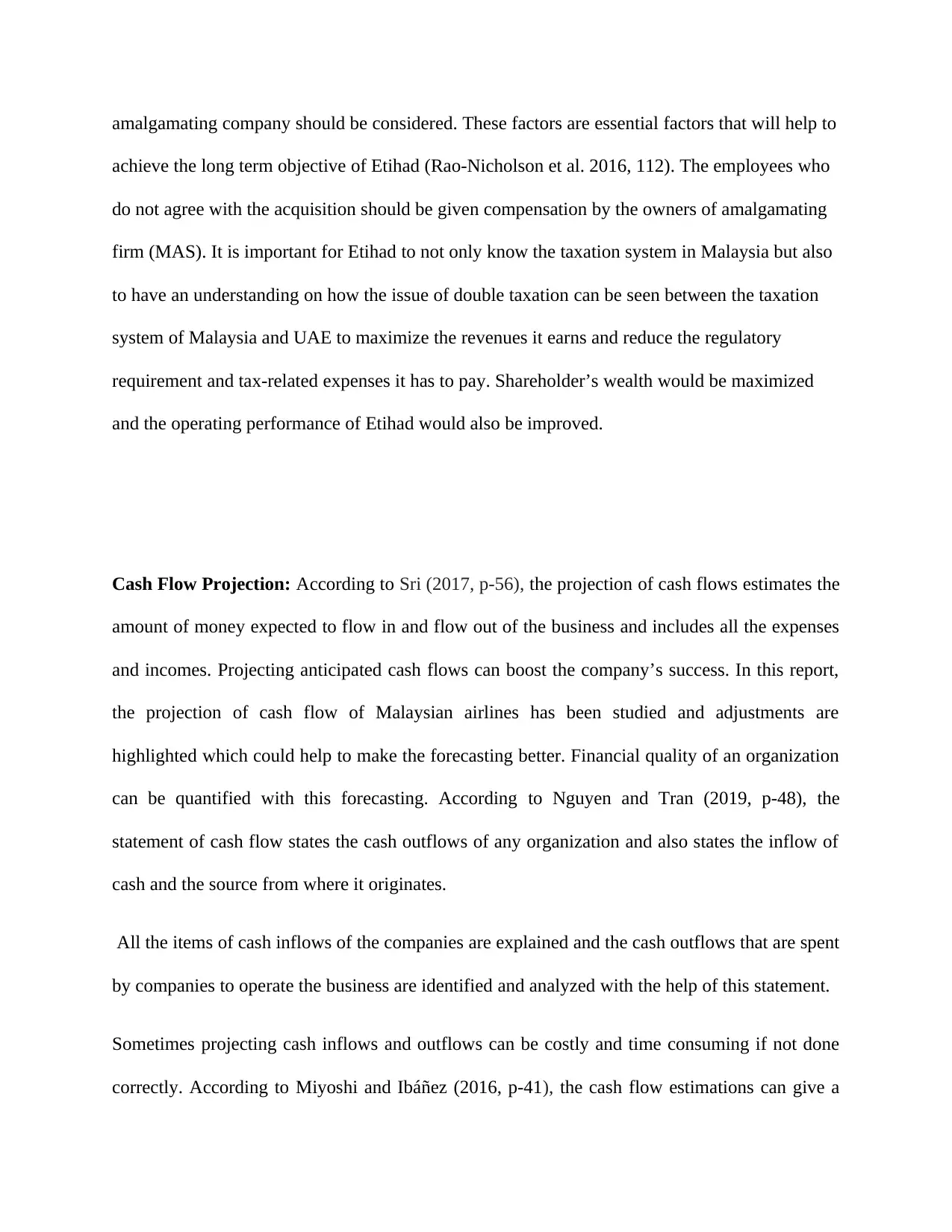
amalgamating company should be considered. These factors are essential factors that will help to
achieve the long term objective of Etihad (Rao-Nicholson et al. 2016, 112). The employees who
do not agree with the acquisition should be given compensation by the owners of amalgamating
firm (MAS). It is important for Etihad to not only know the taxation system in Malaysia but also
to have an understanding on how the issue of double taxation can be seen between the taxation
system of Malaysia and UAE to maximize the revenues it earns and reduce the regulatory
requirement and tax-related expenses it has to pay. Shareholder’s wealth would be maximized
and the operating performance of Etihad would also be improved.
Cash Flow Projection: According to Sri (2017, p-56), the projection of cash flows estimates the
amount of money expected to flow in and flow out of the business and includes all the expenses
and incomes. Projecting anticipated cash flows can boost the company’s success. In this report,
the projection of cash flow of Malaysian airlines has been studied and adjustments are
highlighted which could help to make the forecasting better. Financial quality of an organization
can be quantified with this forecasting. According to Nguyen and Tran (2019, p-48), the
statement of cash flow states the cash outflows of any organization and also states the inflow of
cash and the source from where it originates.
All the items of cash inflows of the companies are explained and the cash outflows that are spent
by companies to operate the business are identified and analyzed with the help of this statement.
Sometimes projecting cash inflows and outflows can be costly and time consuming if not done
correctly. According to Miyoshi and Ibáñez (2016, p-41), the cash flow estimations can give a
achieve the long term objective of Etihad (Rao-Nicholson et al. 2016, 112). The employees who
do not agree with the acquisition should be given compensation by the owners of amalgamating
firm (MAS). It is important for Etihad to not only know the taxation system in Malaysia but also
to have an understanding on how the issue of double taxation can be seen between the taxation
system of Malaysia and UAE to maximize the revenues it earns and reduce the regulatory
requirement and tax-related expenses it has to pay. Shareholder’s wealth would be maximized
and the operating performance of Etihad would also be improved.
Cash Flow Projection: According to Sri (2017, p-56), the projection of cash flows estimates the
amount of money expected to flow in and flow out of the business and includes all the expenses
and incomes. Projecting anticipated cash flows can boost the company’s success. In this report,
the projection of cash flow of Malaysian airlines has been studied and adjustments are
highlighted which could help to make the forecasting better. Financial quality of an organization
can be quantified with this forecasting. According to Nguyen and Tran (2019, p-48), the
statement of cash flow states the cash outflows of any organization and also states the inflow of
cash and the source from where it originates.
All the items of cash inflows of the companies are explained and the cash outflows that are spent
by companies to operate the business are identified and analyzed with the help of this statement.
Sometimes projecting cash inflows and outflows can be costly and time consuming if not done
correctly. According to Miyoshi and Ibáñez (2016, p-41), the cash flow estimations can give a
Secure Best Marks with AI Grader
Need help grading? Try our AI Grader for instant feedback on your assignments.
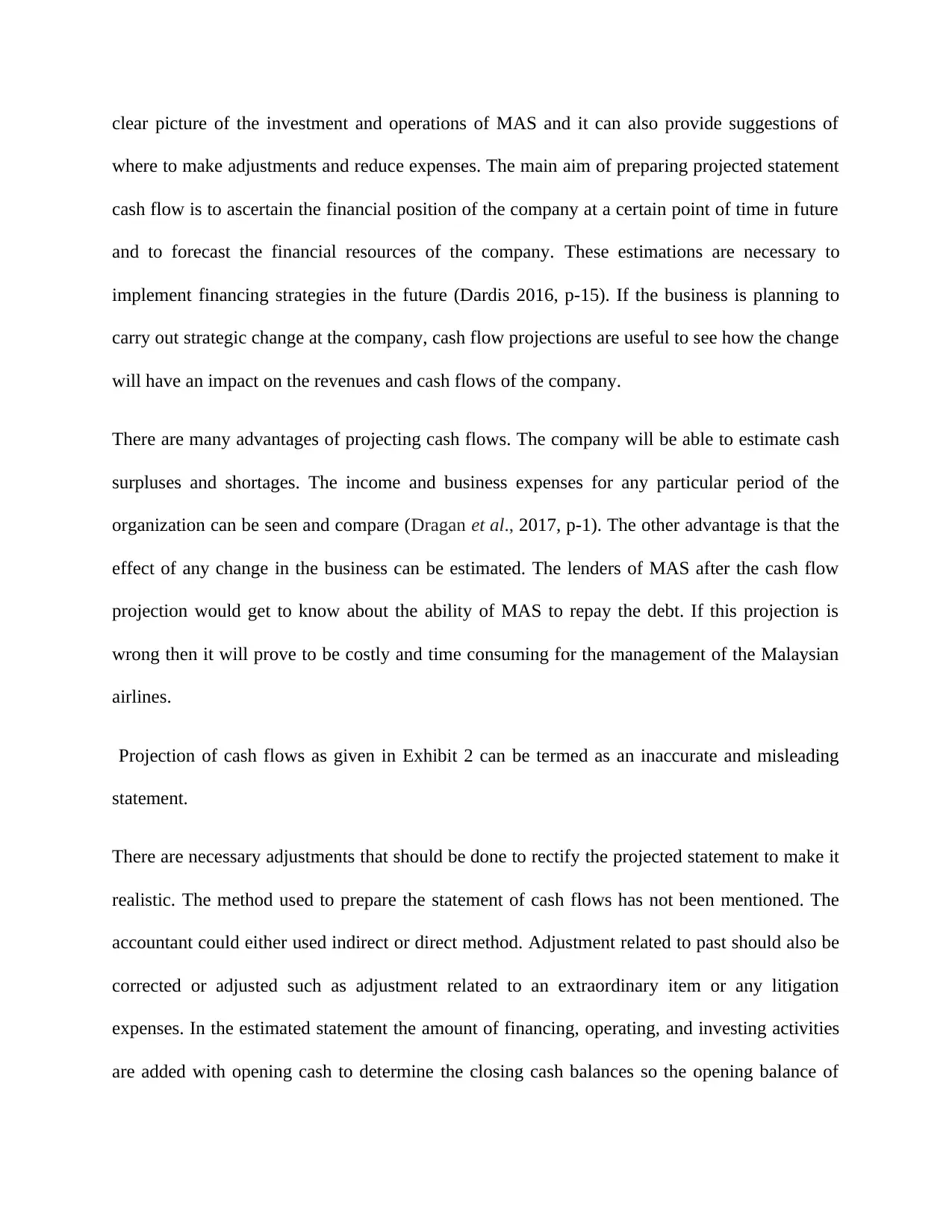
clear picture of the investment and operations of MAS and it can also provide suggestions of
where to make adjustments and reduce expenses. The main aim of preparing projected statement
cash flow is to ascertain the financial position of the company at a certain point of time in future
and to forecast the financial resources of the company. These estimations are necessary to
implement financing strategies in the future (Dardis 2016, p-15). If the business is planning to
carry out strategic change at the company, cash flow projections are useful to see how the change
will have an impact on the revenues and cash flows of the company.
There are many advantages of projecting cash flows. The company will be able to estimate cash
surpluses and shortages. The income and business expenses for any particular period of the
organization can be seen and compare (Dragan et al., 2017, p-1). The other advantage is that the
effect of any change in the business can be estimated. The lenders of MAS after the cash flow
projection would get to know about the ability of MAS to repay the debt. If this projection is
wrong then it will prove to be costly and time consuming for the management of the Malaysian
airlines.
Projection of cash flows as given in Exhibit 2 can be termed as an inaccurate and misleading
statement.
There are necessary adjustments that should be done to rectify the projected statement to make it
realistic. The method used to prepare the statement of cash flows has not been mentioned. The
accountant could either used indirect or direct method. Adjustment related to past should also be
corrected or adjusted such as adjustment related to an extraordinary item or any litigation
expenses. In the estimated statement the amount of financing, operating, and investing activities
are added with opening cash to determine the closing cash balances so the opening balance of
where to make adjustments and reduce expenses. The main aim of preparing projected statement
cash flow is to ascertain the financial position of the company at a certain point of time in future
and to forecast the financial resources of the company. These estimations are necessary to
implement financing strategies in the future (Dardis 2016, p-15). If the business is planning to
carry out strategic change at the company, cash flow projections are useful to see how the change
will have an impact on the revenues and cash flows of the company.
There are many advantages of projecting cash flows. The company will be able to estimate cash
surpluses and shortages. The income and business expenses for any particular period of the
organization can be seen and compare (Dragan et al., 2017, p-1). The other advantage is that the
effect of any change in the business can be estimated. The lenders of MAS after the cash flow
projection would get to know about the ability of MAS to repay the debt. If this projection is
wrong then it will prove to be costly and time consuming for the management of the Malaysian
airlines.
Projection of cash flows as given in Exhibit 2 can be termed as an inaccurate and misleading
statement.
There are necessary adjustments that should be done to rectify the projected statement to make it
realistic. The method used to prepare the statement of cash flows has not been mentioned. The
accountant could either used indirect or direct method. Adjustment related to past should also be
corrected or adjusted such as adjustment related to an extraordinary item or any litigation
expenses. In the estimated statement the amount of financing, operating, and investing activities
are added with opening cash to determine the closing cash balances so the opening balance of
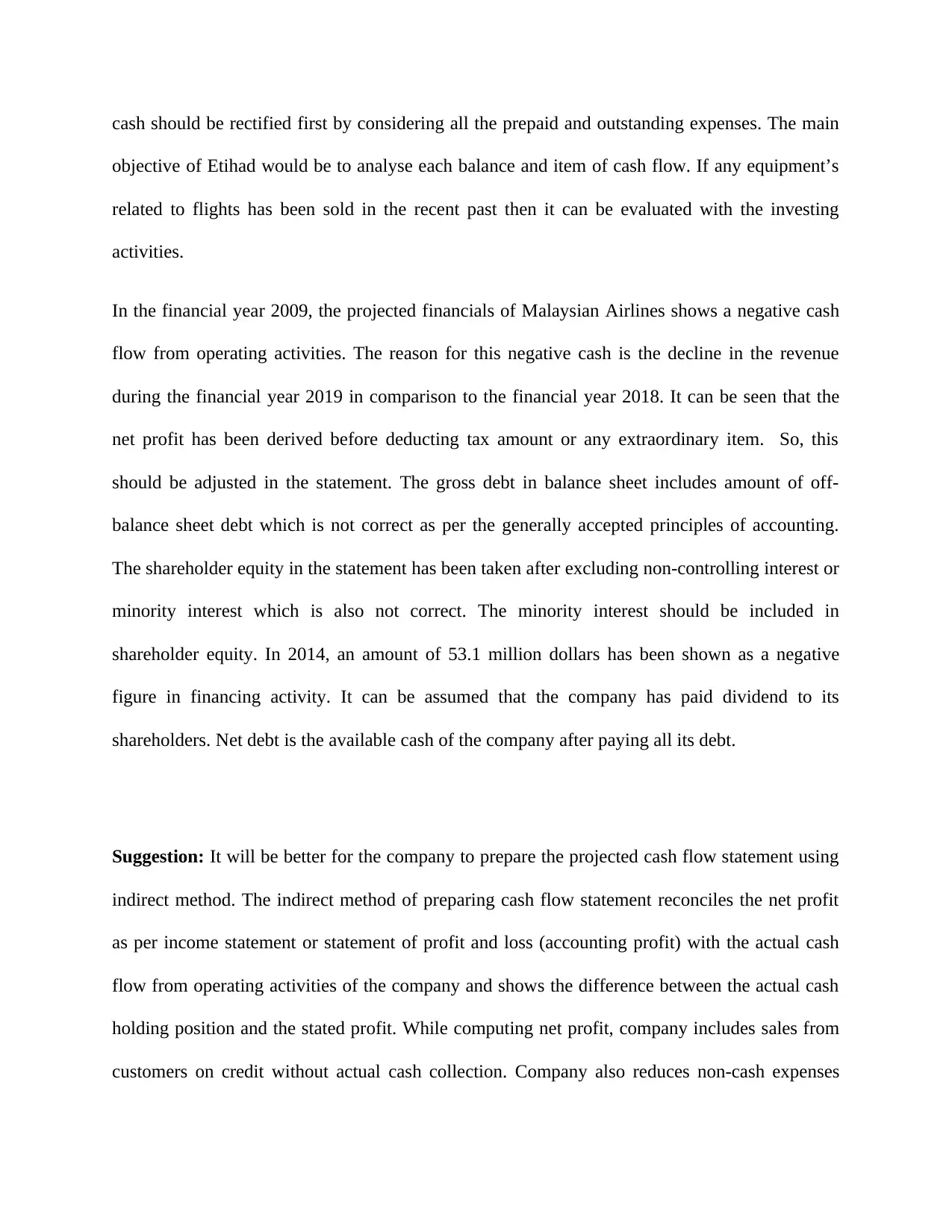
cash should be rectified first by considering all the prepaid and outstanding expenses. The main
objective of Etihad would be to analyse each balance and item of cash flow. If any equipment’s
related to flights has been sold in the recent past then it can be evaluated with the investing
activities.
In the financial year 2009, the projected financials of Malaysian Airlines shows a negative cash
flow from operating activities. The reason for this negative cash is the decline in the revenue
during the financial year 2019 in comparison to the financial year 2018. It can be seen that the
net profit has been derived before deducting tax amount or any extraordinary item. So, this
should be adjusted in the statement. The gross debt in balance sheet includes amount of off-
balance sheet debt which is not correct as per the generally accepted principles of accounting.
The shareholder equity in the statement has been taken after excluding non-controlling interest or
minority interest which is also not correct. The minority interest should be included in
shareholder equity. In 2014, an amount of 53.1 million dollars has been shown as a negative
figure in financing activity. It can be assumed that the company has paid dividend to its
shareholders. Net debt is the available cash of the company after paying all its debt.
Suggestion: It will be better for the company to prepare the projected cash flow statement using
indirect method. The indirect method of preparing cash flow statement reconciles the net profit
as per income statement or statement of profit and loss (accounting profit) with the actual cash
flow from operating activities of the company and shows the difference between the actual cash
holding position and the stated profit. While computing net profit, company includes sales from
customers on credit without actual cash collection. Company also reduces non-cash expenses
objective of Etihad would be to analyse each balance and item of cash flow. If any equipment’s
related to flights has been sold in the recent past then it can be evaluated with the investing
activities.
In the financial year 2009, the projected financials of Malaysian Airlines shows a negative cash
flow from operating activities. The reason for this negative cash is the decline in the revenue
during the financial year 2019 in comparison to the financial year 2018. It can be seen that the
net profit has been derived before deducting tax amount or any extraordinary item. So, this
should be adjusted in the statement. The gross debt in balance sheet includes amount of off-
balance sheet debt which is not correct as per the generally accepted principles of accounting.
The shareholder equity in the statement has been taken after excluding non-controlling interest or
minority interest which is also not correct. The minority interest should be included in
shareholder equity. In 2014, an amount of 53.1 million dollars has been shown as a negative
figure in financing activity. It can be assumed that the company has paid dividend to its
shareholders. Net debt is the available cash of the company after paying all its debt.
Suggestion: It will be better for the company to prepare the projected cash flow statement using
indirect method. The indirect method of preparing cash flow statement reconciles the net profit
as per income statement or statement of profit and loss (accounting profit) with the actual cash
flow from operating activities of the company and shows the difference between the actual cash
holding position and the stated profit. While computing net profit, company includes sales from
customers on credit without actual cash collection. Company also reduces non-cash expenses
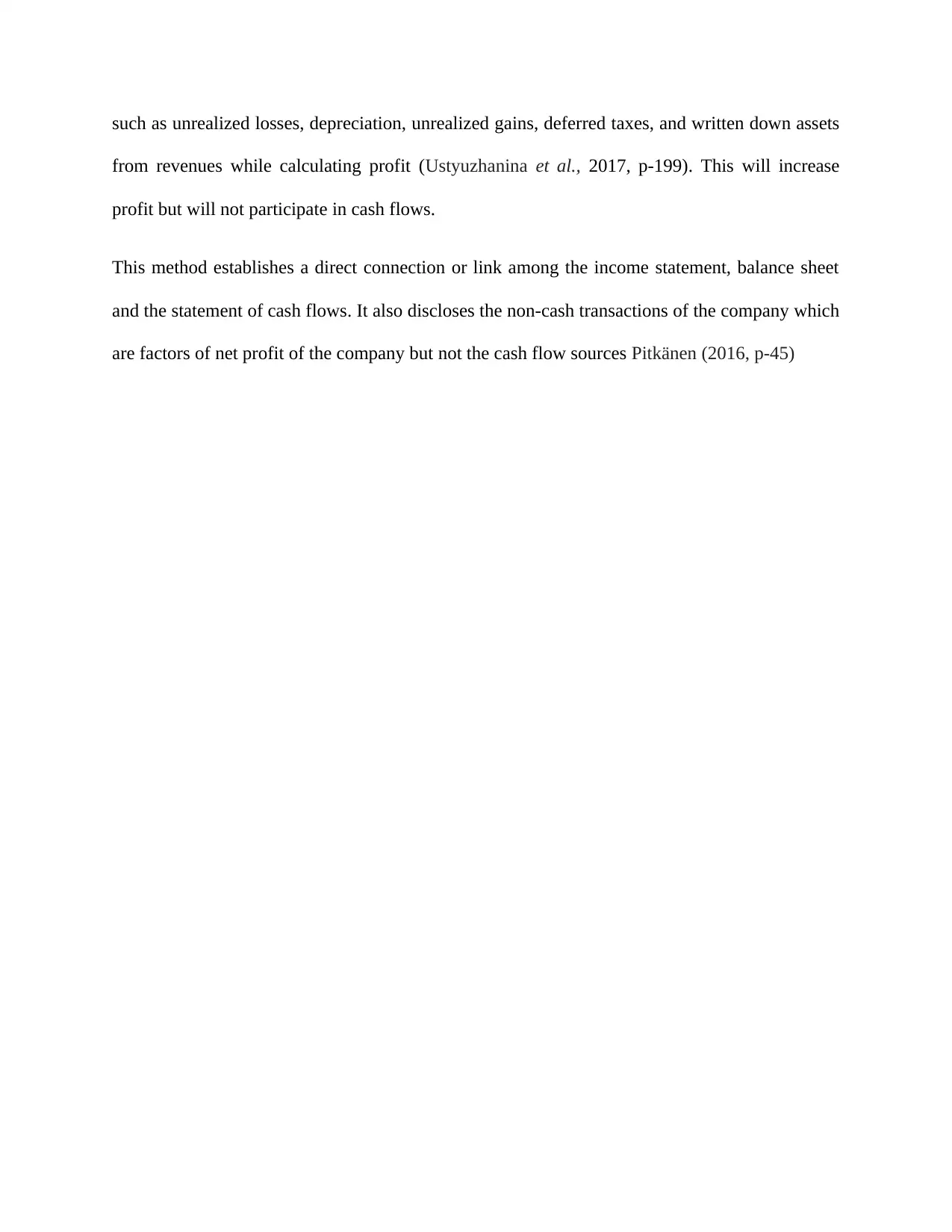
such as unrealized losses, depreciation, unrealized gains, deferred taxes, and written down assets
from revenues while calculating profit (Ustyuzhanina et al., 2017, p-199). This will increase
profit but will not participate in cash flows.
This method establishes a direct connection or link among the income statement, balance sheet
and the statement of cash flows. It also discloses the non-cash transactions of the company which
are factors of net profit of the company but not the cash flow sources Pitkänen (2016, p-45)
from revenues while calculating profit (Ustyuzhanina et al., 2017, p-199). This will increase
profit but will not participate in cash flows.
This method establishes a direct connection or link among the income statement, balance sheet
and the statement of cash flows. It also discloses the non-cash transactions of the company which
are factors of net profit of the company but not the cash flow sources Pitkänen (2016, p-45)
Paraphrase This Document
Need a fresh take? Get an instant paraphrase of this document with our AI Paraphraser
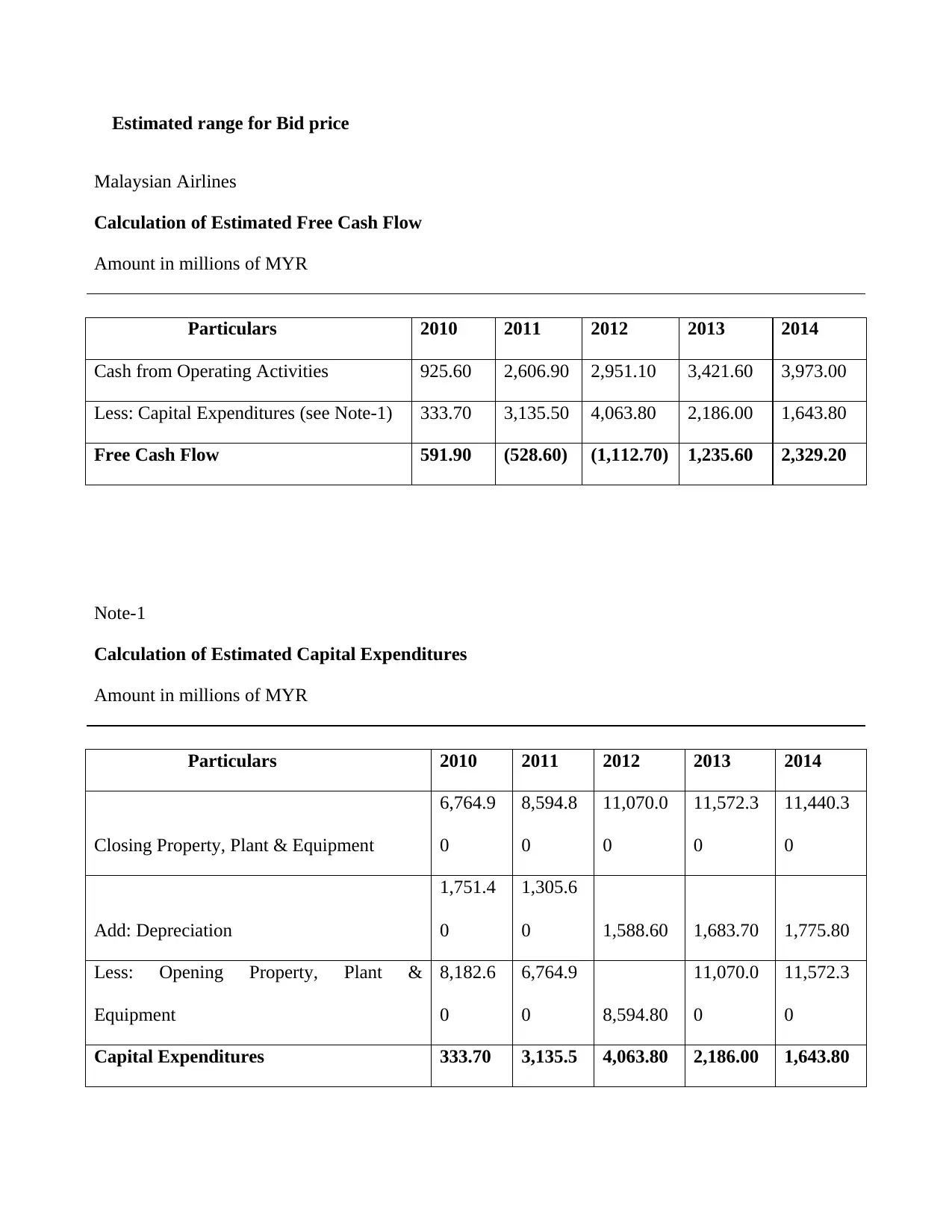
Estimated range for Bid price
Malaysian Airlines
Calculation of Estimated Free Cash Flow
Amount in millions of MYR
Particulars 2010 2011 2012 2013 2014
Cash from Operating Activities 925.60 2,606.90 2,951.10 3,421.60 3,973.00
Less: Capital Expenditures (see Note-1) 333.70 3,135.50 4,063.80 2,186.00 1,643.80
Free Cash Flow 591.90 (528.60) (1,112.70) 1,235.60 2,329.20
Note-1
Calculation of Estimated Capital Expenditures
Amount in millions of MYR
Particulars 2010 2011 2012 2013 2014
Closing Property, Plant & Equipment
6,764.9
0
8,594.8
0
11,070.0
0
11,572.3
0
11,440.3
0
Add: Depreciation
1,751.4
0
1,305.6
0 1,588.60 1,683.70 1,775.80
Less: Opening Property, Plant &
Equipment
8,182.6
0
6,764.9
0 8,594.80
11,070.0
0
11,572.3
0
Capital Expenditures 333.70 3,135.5 4,063.80 2,186.00 1,643.80
Malaysian Airlines
Calculation of Estimated Free Cash Flow
Amount in millions of MYR
Particulars 2010 2011 2012 2013 2014
Cash from Operating Activities 925.60 2,606.90 2,951.10 3,421.60 3,973.00
Less: Capital Expenditures (see Note-1) 333.70 3,135.50 4,063.80 2,186.00 1,643.80
Free Cash Flow 591.90 (528.60) (1,112.70) 1,235.60 2,329.20
Note-1
Calculation of Estimated Capital Expenditures
Amount in millions of MYR
Particulars 2010 2011 2012 2013 2014
Closing Property, Plant & Equipment
6,764.9
0
8,594.8
0
11,070.0
0
11,572.3
0
11,440.3
0
Add: Depreciation
1,751.4
0
1,305.6
0 1,588.60 1,683.70 1,775.80
Less: Opening Property, Plant &
Equipment
8,182.6
0
6,764.9
0 8,594.80
11,070.0
0
11,572.3
0
Capital Expenditures 333.70 3,135.5 4,063.80 2,186.00 1,643.80

0
Calculation of Weighted Average Cost of Capital (Ko)
Risk Free Rate (Rf) = 3.68%
Market Risk Premium (Rm – Rf) = 9.38%
Beta (β) = 1.06
Therefore, Cost of Equity (Ke) = Rf + β (Rm – Rf)
= 3.68 + 1.06 x 9.38
= 3.68 + 9.94
= 13.62%
Cost of Debt (Kd) = 3.09%
Year
Net
Debt
Shareholders
'
Equity
Total
2010 4133.5 913
2011 4662.1 2058.1
2012 5774.9 3252
Calculation of Weighted Average Cost of Capital (Ko)
Risk Free Rate (Rf) = 3.68%
Market Risk Premium (Rm – Rf) = 9.38%
Beta (β) = 1.06
Therefore, Cost of Equity (Ke) = Rf + β (Rm – Rf)
= 3.68 + 1.06 x 9.38
= 3.68 + 9.94
= 13.62%
Cost of Debt (Kd) = 3.09%
Year
Net
Debt
Shareholders
'
Equity
Total
2010 4133.5 913
2011 4662.1 2058.1
2012 5774.9 3252
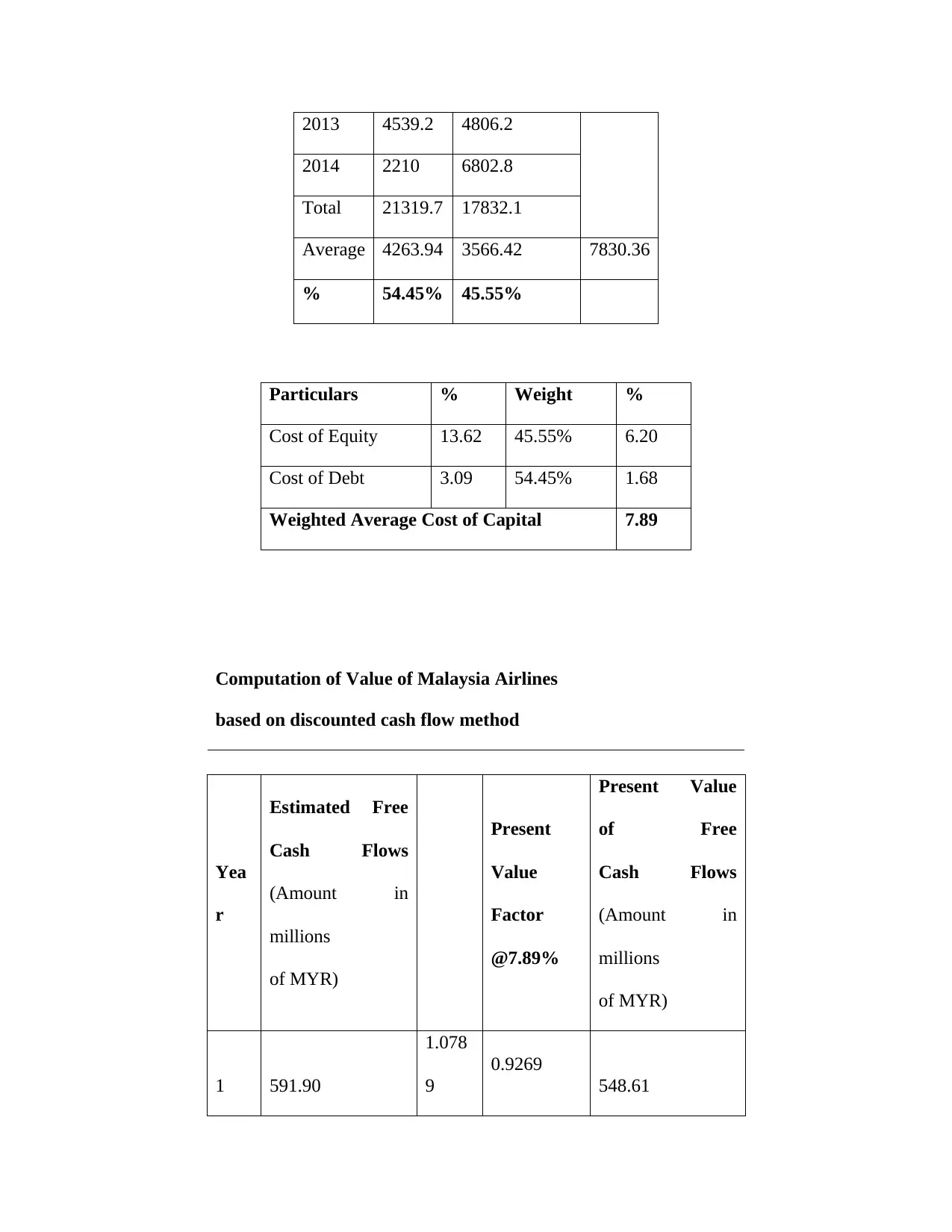
2013 4539.2 4806.2
2014 2210 6802.8
Total 21319.7 17832.1
Average 4263.94 3566.42 7830.36
% 54.45% 45.55%
Particulars % Weight %
Cost of Equity 13.62 45.55% 6.20
Cost of Debt 3.09 54.45% 1.68
Weighted Average Cost of Capital 7.89
Computation of Value of Malaysia Airlines
based on discounted cash flow method
Yea
r
Estimated Free
Cash Flows
(Amount in
millions
of MYR)
Present
Value
Factor
@7.89%
Present Value
of Free
Cash Flows
(Amount in
millions
of MYR)
1 591.90
1.078
9
0.9269
548.61
2014 2210 6802.8
Total 21319.7 17832.1
Average 4263.94 3566.42 7830.36
% 54.45% 45.55%
Particulars % Weight %
Cost of Equity 13.62 45.55% 6.20
Cost of Debt 3.09 54.45% 1.68
Weighted Average Cost of Capital 7.89
Computation of Value of Malaysia Airlines
based on discounted cash flow method
Yea
r
Estimated Free
Cash Flows
(Amount in
millions
of MYR)
Present
Value
Factor
@7.89%
Present Value
of Free
Cash Flows
(Amount in
millions
of MYR)
1 591.90
1.078
9
0.9269
548.61
Secure Best Marks with AI Grader
Need help grading? Try our AI Grader for instant feedback on your assignments.
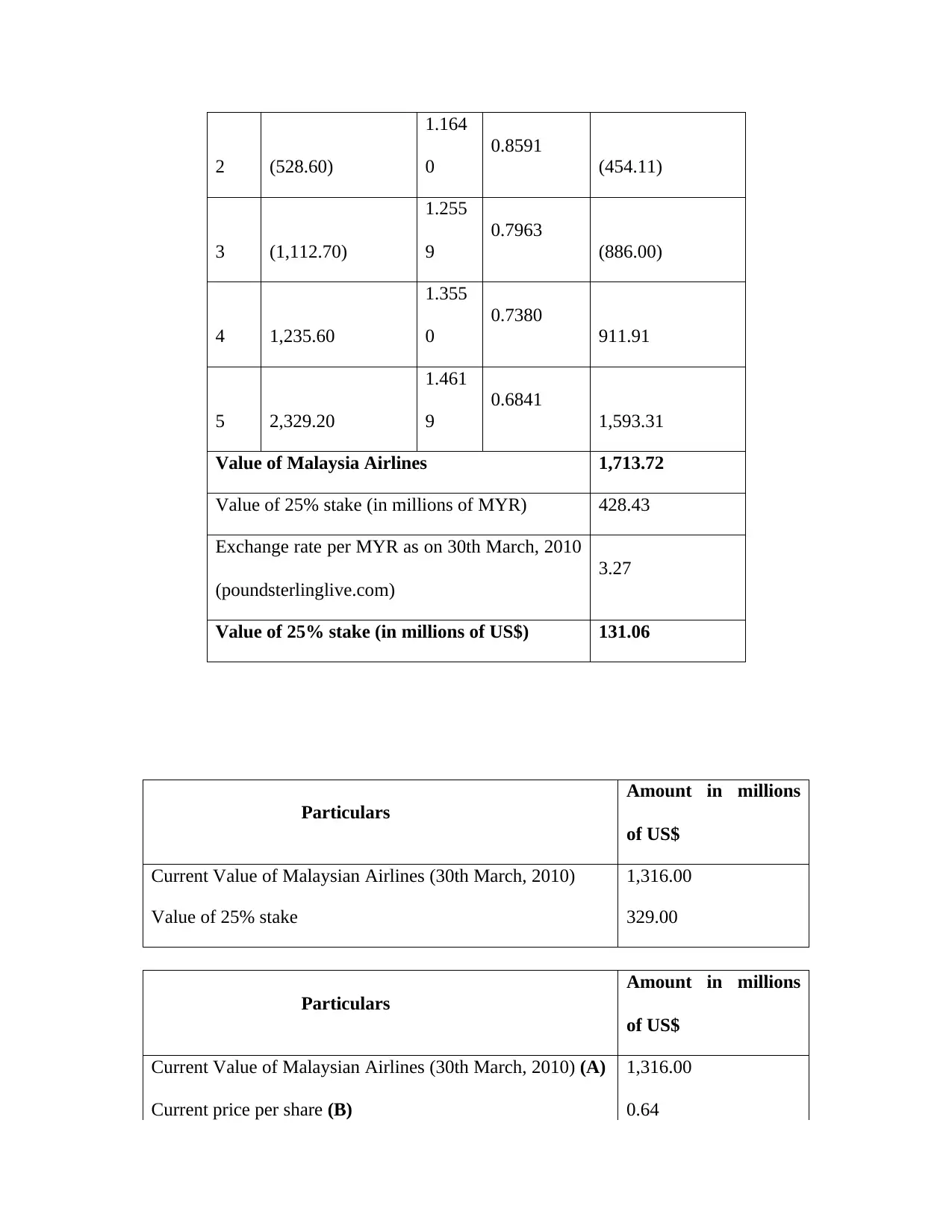
2 (528.60)
1.164
0
0.8591
(454.11)
3 (1,112.70)
1.255
9
0.7963
(886.00)
4 1,235.60
1.355
0
0.7380
911.91
5 2,329.20
1.461
9
0.6841
1,593.31
Value of Malaysia Airlines 1,713.72
Value of 25% stake (in millions of MYR) 428.43
Exchange rate per MYR as on 30th March, 2010
(poundsterlinglive.com)
3.27
Value of 25% stake (in millions of US$) 131.06
Particulars
Amount in millions
of US$
Current Value of Malaysian Airlines (30th March, 2010) 1,316.00
Value of 25% stake 329.00
Particulars
Amount in millions
of US$
Current Value of Malaysian Airlines (30th March, 2010) (A) 1,316.00
Current price per share (B) 0.64
1.164
0
0.8591
(454.11)
3 (1,112.70)
1.255
9
0.7963
(886.00)
4 1,235.60
1.355
0
0.7380
911.91
5 2,329.20
1.461
9
0.6841
1,593.31
Value of Malaysia Airlines 1,713.72
Value of 25% stake (in millions of MYR) 428.43
Exchange rate per MYR as on 30th March, 2010
(poundsterlinglive.com)
3.27
Value of 25% stake (in millions of US$) 131.06
Particulars
Amount in millions
of US$
Current Value of Malaysian Airlines (30th March, 2010) 1,316.00
Value of 25% stake 329.00
Particulars
Amount in millions
of US$
Current Value of Malaysian Airlines (30th March, 2010) (A) 1,316.00
Current price per share (B) 0.64
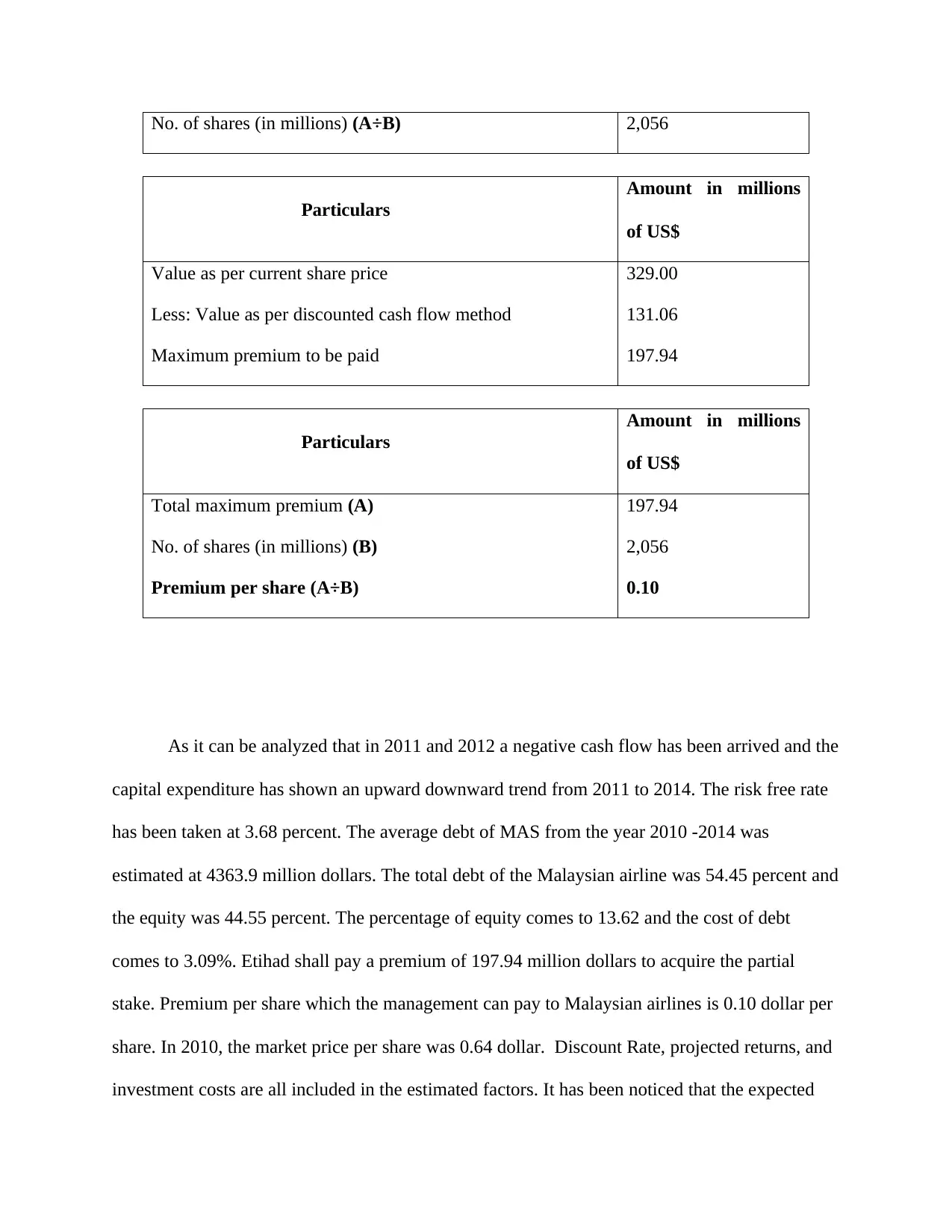
No. of shares (in millions) (A÷B) 2,056
Particulars
Amount in millions
of US$
Value as per current share price 329.00
Less: Value as per discounted cash flow method 131.06
Maximum premium to be paid 197.94
Particulars
Amount in millions
of US$
Total maximum premium (A) 197.94
No. of shares (in millions) (B) 2,056
Premium per share (A÷B) 0.10
As it can be analyzed that in 2011 and 2012 a negative cash flow has been arrived and the
capital expenditure has shown an upward downward trend from 2011 to 2014. The risk free rate
has been taken at 3.68 percent. The average debt of MAS from the year 2010 -2014 was
estimated at 4363.9 million dollars. The total debt of the Malaysian airline was 54.45 percent and
the equity was 44.55 percent. The percentage of equity comes to 13.62 and the cost of debt
comes to 3.09%. Etihad shall pay a premium of 197.94 million dollars to acquire the partial
stake. Premium per share which the management can pay to Malaysian airlines is 0.10 dollar per
share. In 2010, the market price per share was 0.64 dollar. Discount Rate, projected returns, and
investment costs are all included in the estimated factors. It has been noticed that the expected
Particulars
Amount in millions
of US$
Value as per current share price 329.00
Less: Value as per discounted cash flow method 131.06
Maximum premium to be paid 197.94
Particulars
Amount in millions
of US$
Total maximum premium (A) 197.94
No. of shares (in millions) (B) 2,056
Premium per share (A÷B) 0.10
As it can be analyzed that in 2011 and 2012 a negative cash flow has been arrived and the
capital expenditure has shown an upward downward trend from 2011 to 2014. The risk free rate
has been taken at 3.68 percent. The average debt of MAS from the year 2010 -2014 was
estimated at 4363.9 million dollars. The total debt of the Malaysian airline was 54.45 percent and
the equity was 44.55 percent. The percentage of equity comes to 13.62 and the cost of debt
comes to 3.09%. Etihad shall pay a premium of 197.94 million dollars to acquire the partial
stake. Premium per share which the management can pay to Malaysian airlines is 0.10 dollar per
share. In 2010, the market price per share was 0.64 dollar. Discount Rate, projected returns, and
investment costs are all included in the estimated factors. It has been noticed that the expected
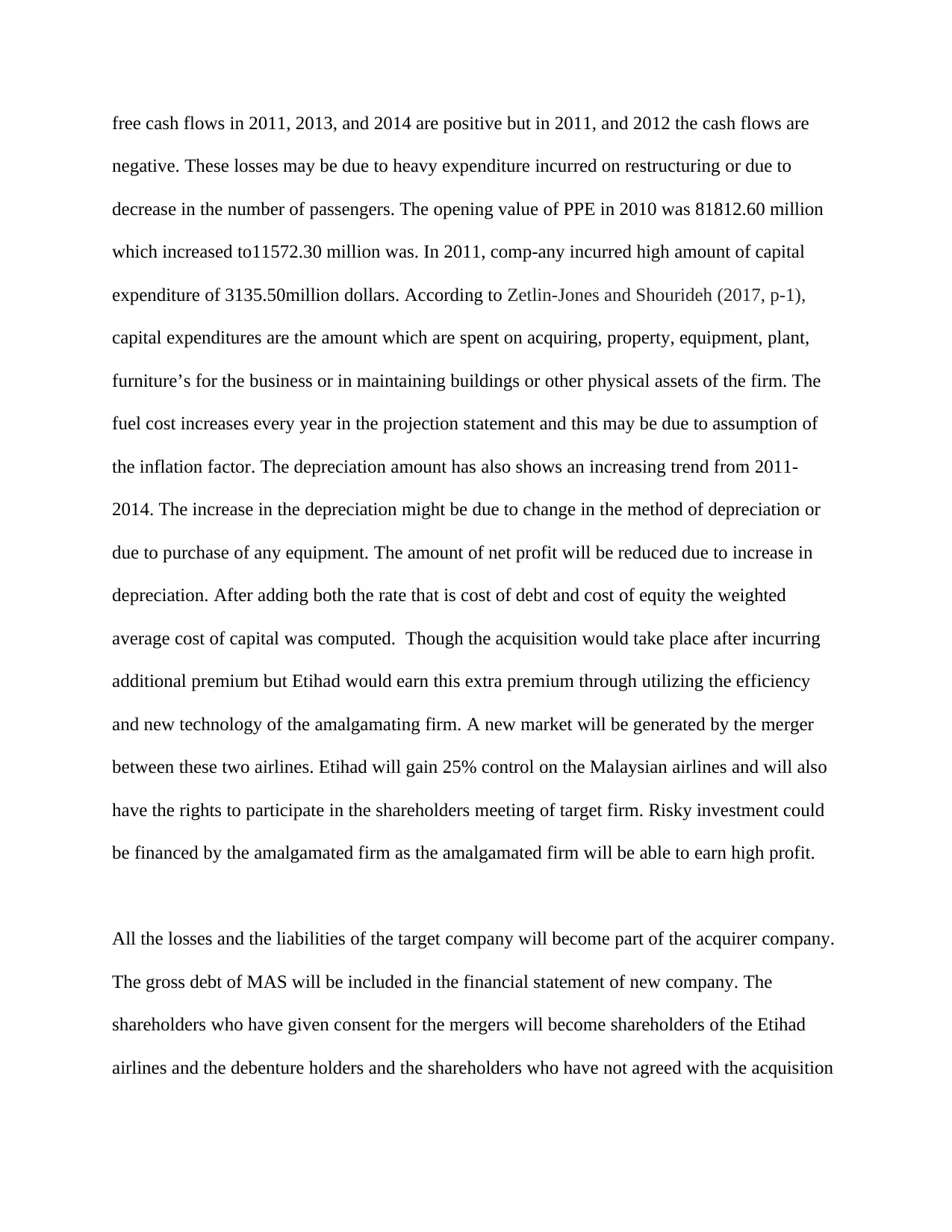
free cash flows in 2011, 2013, and 2014 are positive but in 2011, and 2012 the cash flows are
negative. These losses may be due to heavy expenditure incurred on restructuring or due to
decrease in the number of passengers. The opening value of PPE in 2010 was 81812.60 million
which increased to11572.30 million was. In 2011, comp-any incurred high amount of capital
expenditure of 3135.50million dollars. According to Zetlin-Jones and Shourideh (2017, p-1),
capital expenditures are the amount which are spent on acquiring, property, equipment, plant,
furniture’s for the business or in maintaining buildings or other physical assets of the firm. The
fuel cost increases every year in the projection statement and this may be due to assumption of
the inflation factor. The depreciation amount has also shows an increasing trend from 2011-
2014. The increase in the depreciation might be due to change in the method of depreciation or
due to purchase of any equipment. The amount of net profit will be reduced due to increase in
depreciation. After adding both the rate that is cost of debt and cost of equity the weighted
average cost of capital was computed. Though the acquisition would take place after incurring
additional premium but Etihad would earn this extra premium through utilizing the efficiency
and new technology of the amalgamating firm. A new market will be generated by the merger
between these two airlines. Etihad will gain 25% control on the Malaysian airlines and will also
have the rights to participate in the shareholders meeting of target firm. Risky investment could
be financed by the amalgamated firm as the amalgamated firm will be able to earn high profit.
All the losses and the liabilities of the target company will become part of the acquirer company.
The gross debt of MAS will be included in the financial statement of new company. The
shareholders who have given consent for the mergers will become shareholders of the Etihad
airlines and the debenture holders and the shareholders who have not agreed with the acquisition
negative. These losses may be due to heavy expenditure incurred on restructuring or due to
decrease in the number of passengers. The opening value of PPE in 2010 was 81812.60 million
which increased to11572.30 million was. In 2011, comp-any incurred high amount of capital
expenditure of 3135.50million dollars. According to Zetlin-Jones and Shourideh (2017, p-1),
capital expenditures are the amount which are spent on acquiring, property, equipment, plant,
furniture’s for the business or in maintaining buildings or other physical assets of the firm. The
fuel cost increases every year in the projection statement and this may be due to assumption of
the inflation factor. The depreciation amount has also shows an increasing trend from 2011-
2014. The increase in the depreciation might be due to change in the method of depreciation or
due to purchase of any equipment. The amount of net profit will be reduced due to increase in
depreciation. After adding both the rate that is cost of debt and cost of equity the weighted
average cost of capital was computed. Though the acquisition would take place after incurring
additional premium but Etihad would earn this extra premium through utilizing the efficiency
and new technology of the amalgamating firm. A new market will be generated by the merger
between these two airlines. Etihad will gain 25% control on the Malaysian airlines and will also
have the rights to participate in the shareholders meeting of target firm. Risky investment could
be financed by the amalgamated firm as the amalgamated firm will be able to earn high profit.
All the losses and the liabilities of the target company will become part of the acquirer company.
The gross debt of MAS will be included in the financial statement of new company. The
shareholders who have given consent for the mergers will become shareholders of the Etihad
airlines and the debenture holders and the shareholders who have not agreed with the acquisition
Paraphrase This Document
Need a fresh take? Get an instant paraphrase of this document with our AI Paraphraser
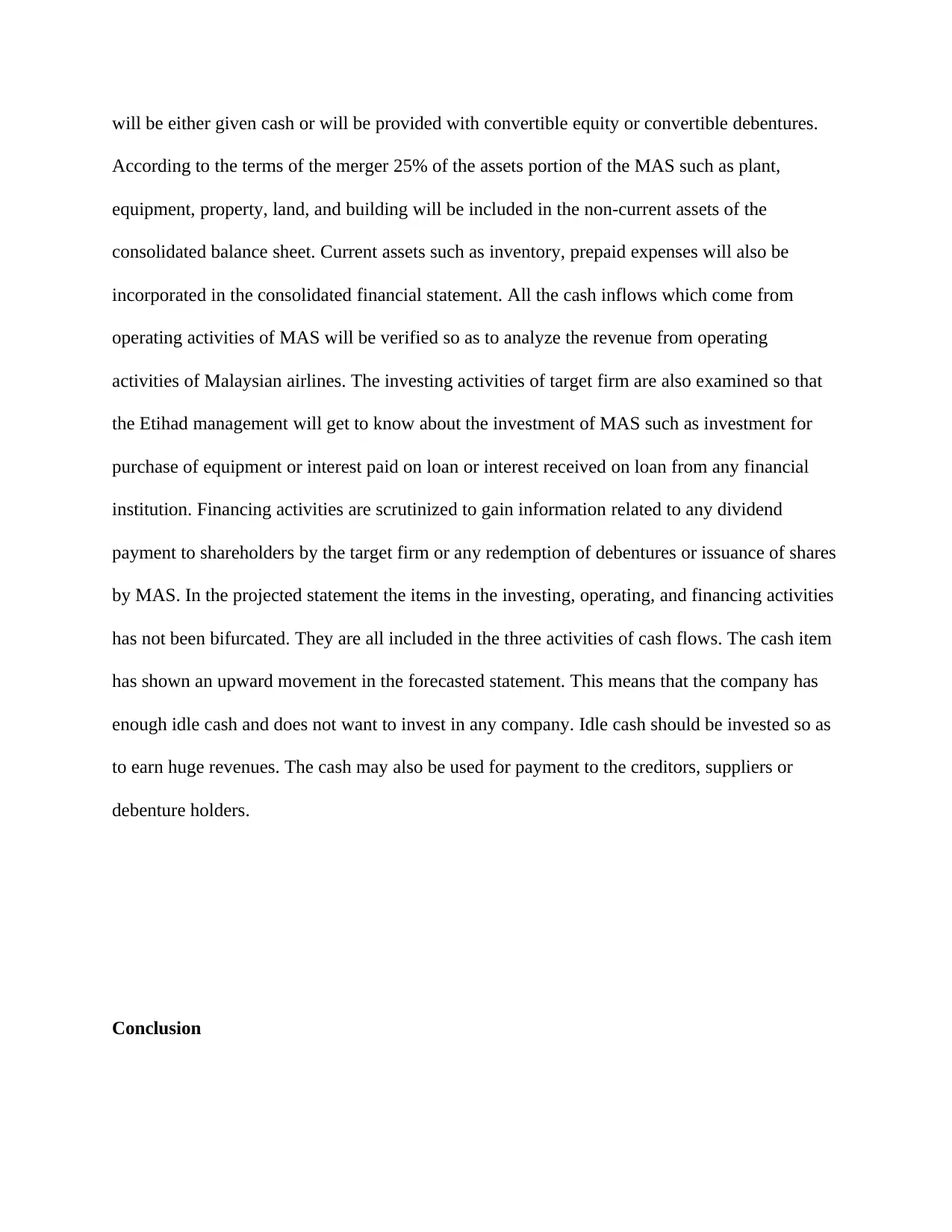
will be either given cash or will be provided with convertible equity or convertible debentures.
According to the terms of the merger 25% of the assets portion of the MAS such as plant,
equipment, property, land, and building will be included in the non-current assets of the
consolidated balance sheet. Current assets such as inventory, prepaid expenses will also be
incorporated in the consolidated financial statement. All the cash inflows which come from
operating activities of MAS will be verified so as to analyze the revenue from operating
activities of Malaysian airlines. The investing activities of target firm are also examined so that
the Etihad management will get to know about the investment of MAS such as investment for
purchase of equipment or interest paid on loan or interest received on loan from any financial
institution. Financing activities are scrutinized to gain information related to any dividend
payment to shareholders by the target firm or any redemption of debentures or issuance of shares
by MAS. In the projected statement the items in the investing, operating, and financing activities
has not been bifurcated. They are all included in the three activities of cash flows. The cash item
has shown an upward movement in the forecasted statement. This means that the company has
enough idle cash and does not want to invest in any company. Idle cash should be invested so as
to earn huge revenues. The cash may also be used for payment to the creditors, suppliers or
debenture holders.
Conclusion
According to the terms of the merger 25% of the assets portion of the MAS such as plant,
equipment, property, land, and building will be included in the non-current assets of the
consolidated balance sheet. Current assets such as inventory, prepaid expenses will also be
incorporated in the consolidated financial statement. All the cash inflows which come from
operating activities of MAS will be verified so as to analyze the revenue from operating
activities of Malaysian airlines. The investing activities of target firm are also examined so that
the Etihad management will get to know about the investment of MAS such as investment for
purchase of equipment or interest paid on loan or interest received on loan from any financial
institution. Financing activities are scrutinized to gain information related to any dividend
payment to shareholders by the target firm or any redemption of debentures or issuance of shares
by MAS. In the projected statement the items in the investing, operating, and financing activities
has not been bifurcated. They are all included in the three activities of cash flows. The cash item
has shown an upward movement in the forecasted statement. This means that the company has
enough idle cash and does not want to invest in any company. Idle cash should be invested so as
to earn huge revenues. The cash may also be used for payment to the creditors, suppliers or
debenture holders.
Conclusion
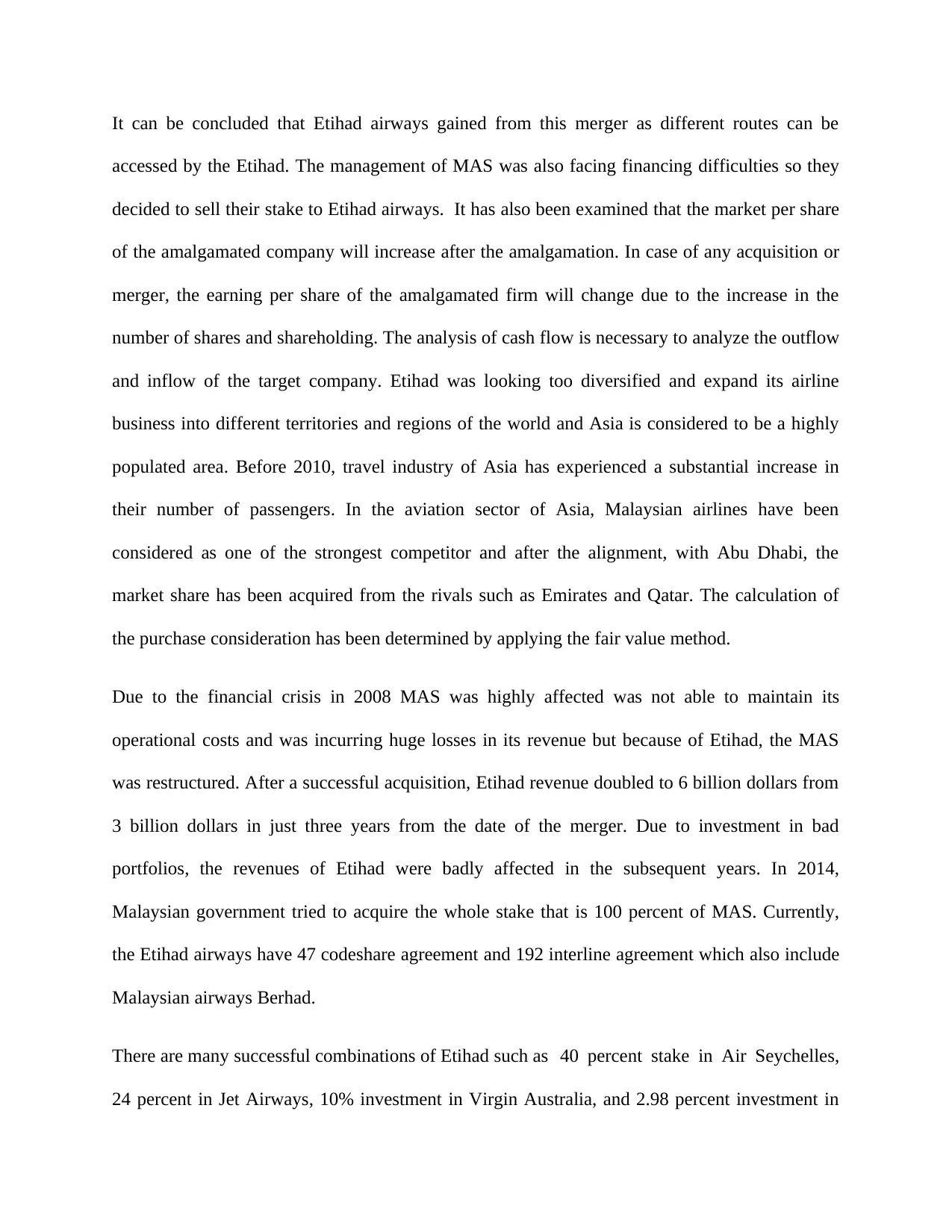
It can be concluded that Etihad airways gained from this merger as different routes can be
accessed by the Etihad. The management of MAS was also facing financing difficulties so they
decided to sell their stake to Etihad airways. It has also been examined that the market per share
of the amalgamated company will increase after the amalgamation. In case of any acquisition or
merger, the earning per share of the amalgamated firm will change due to the increase in the
number of shares and shareholding. The analysis of cash flow is necessary to analyze the outflow
and inflow of the target company. Etihad was looking too diversified and expand its airline
business into different territories and regions of the world and Asia is considered to be a highly
populated area. Before 2010, travel industry of Asia has experienced a substantial increase in
their number of passengers. In the aviation sector of Asia, Malaysian airlines have been
considered as one of the strongest competitor and after the alignment, with Abu Dhabi, the
market share has been acquired from the rivals such as Emirates and Qatar. The calculation of
the purchase consideration has been determined by applying the fair value method.
Due to the financial crisis in 2008 MAS was highly affected was not able to maintain its
operational costs and was incurring huge losses in its revenue but because of Etihad, the MAS
was restructured. After a successful acquisition, Etihad revenue doubled to 6 billion dollars from
3 billion dollars in just three years from the date of the merger. Due to investment in bad
portfolios, the revenues of Etihad were badly affected in the subsequent years. In 2014,
Malaysian government tried to acquire the whole stake that is 100 percent of MAS. Currently,
the Etihad airways have 47 codeshare agreement and 192 interline agreement which also include
Malaysian airways Berhad.
There are many successful combinations of Etihad such as 40 percent stake in Air Seychelles,
24 percent in Jet Airways, 10% investment in Virgin Australia, and 2.98 percent investment in
accessed by the Etihad. The management of MAS was also facing financing difficulties so they
decided to sell their stake to Etihad airways. It has also been examined that the market per share
of the amalgamated company will increase after the amalgamation. In case of any acquisition or
merger, the earning per share of the amalgamated firm will change due to the increase in the
number of shares and shareholding. The analysis of cash flow is necessary to analyze the outflow
and inflow of the target company. Etihad was looking too diversified and expand its airline
business into different territories and regions of the world and Asia is considered to be a highly
populated area. Before 2010, travel industry of Asia has experienced a substantial increase in
their number of passengers. In the aviation sector of Asia, Malaysian airlines have been
considered as one of the strongest competitor and after the alignment, with Abu Dhabi, the
market share has been acquired from the rivals such as Emirates and Qatar. The calculation of
the purchase consideration has been determined by applying the fair value method.
Due to the financial crisis in 2008 MAS was highly affected was not able to maintain its
operational costs and was incurring huge losses in its revenue but because of Etihad, the MAS
was restructured. After a successful acquisition, Etihad revenue doubled to 6 billion dollars from
3 billion dollars in just three years from the date of the merger. Due to investment in bad
portfolios, the revenues of Etihad were badly affected in the subsequent years. In 2014,
Malaysian government tried to acquire the whole stake that is 100 percent of MAS. Currently,
the Etihad airways have 47 codeshare agreement and 192 interline agreement which also include
Malaysian airways Berhad.
There are many successful combinations of Etihad such as 40 percent stake in Air Seychelles,
24 percent in Jet Airways, 10% investment in Virgin Australia, and 2.98 percent investment in
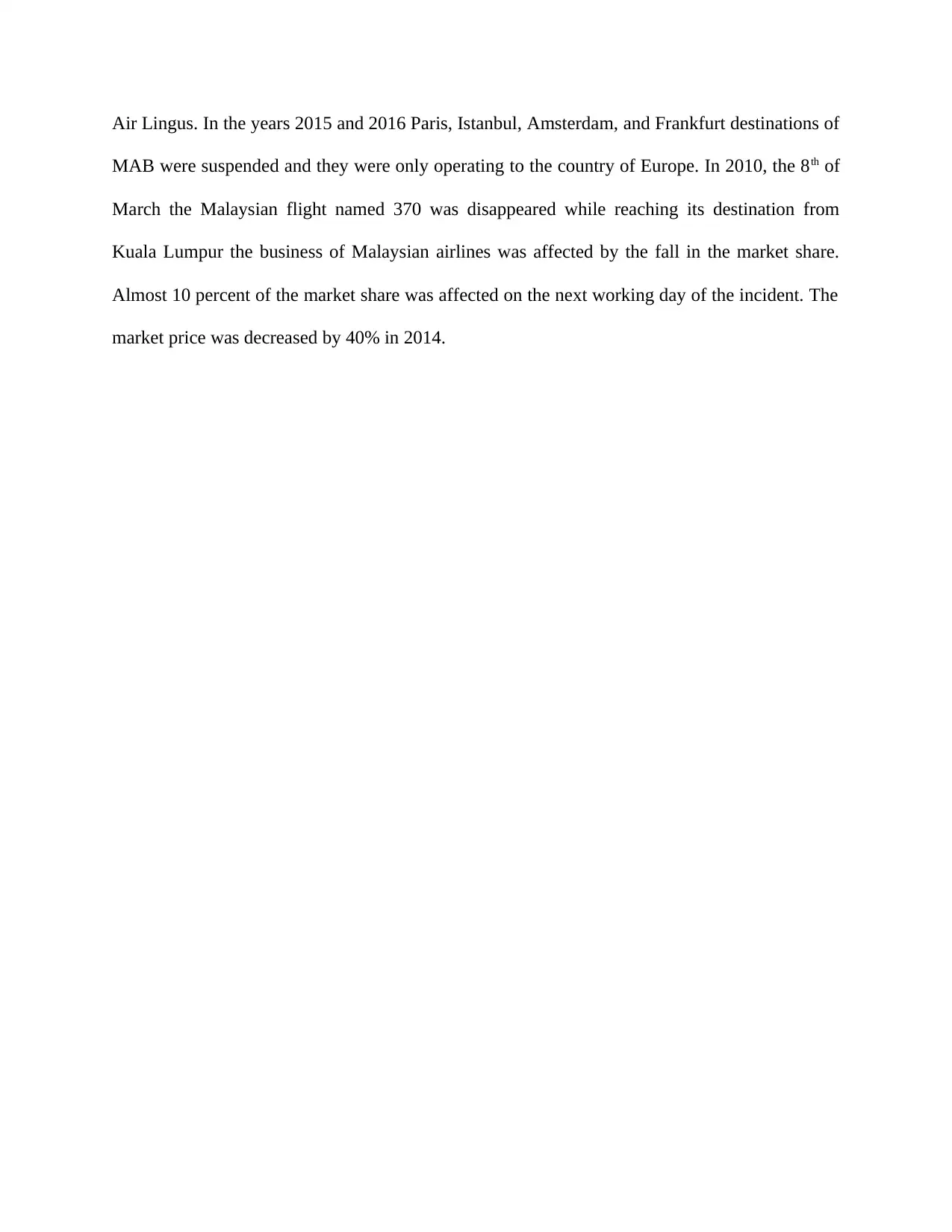
Air Lingus. In the years 2015 and 2016 Paris, Istanbul, Amsterdam, and Frankfurt destinations of
MAB were suspended and they were only operating to the country of Europe. In 2010, the 8th of
March the Malaysian flight named 370 was disappeared while reaching its destination from
Kuala Lumpur the business of Malaysian airlines was affected by the fall in the market share.
Almost 10 percent of the market share was affected on the next working day of the incident. The
market price was decreased by 40% in 2014.
MAB were suspended and they were only operating to the country of Europe. In 2010, the 8th of
March the Malaysian flight named 370 was disappeared while reaching its destination from
Kuala Lumpur the business of Malaysian airlines was affected by the fall in the market share.
Almost 10 percent of the market share was affected on the next working day of the incident. The
market price was decreased by 40% in 2014.
Secure Best Marks with AI Grader
Need help grading? Try our AI Grader for instant feedback on your assignments.
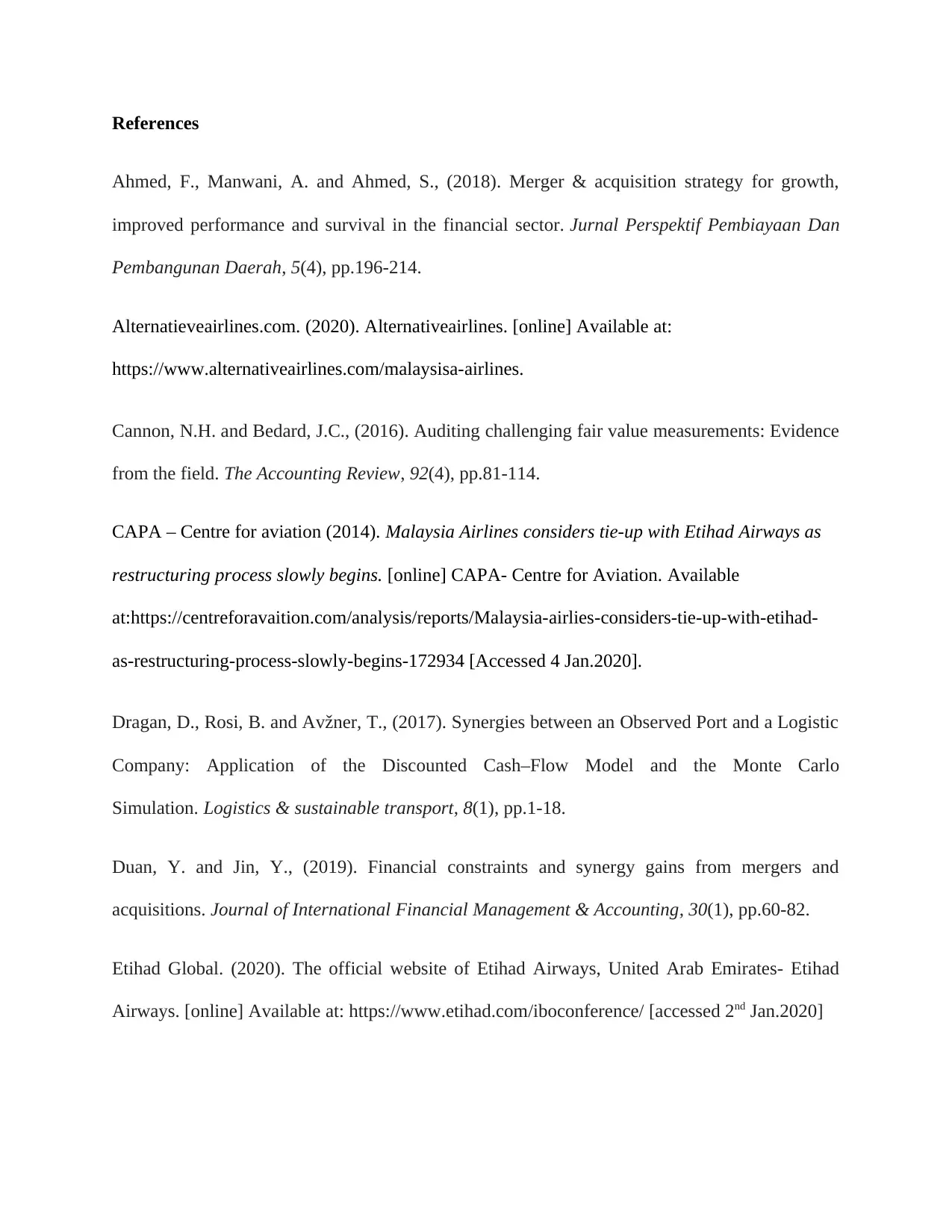
References
Ahmed, F., Manwani, A. and Ahmed, S., (2018). Merger & acquisition strategy for growth,
improved performance and survival in the financial sector. Jurnal Perspektif Pembiayaan Dan
Pembangunan Daerah, 5(4), pp.196-214.
Alternatieveairlines.com. (2020). Alternativeairlines. [online] Available at:
https://www.alternativeairlines.com/malaysisa-airlines.
Cannon, N.H. and Bedard, J.C., (2016). Auditing challenging fair value measurements: Evidence
from the field. The Accounting Review, 92(4), pp.81-114.
CAPA – Centre for aviation (2014). Malaysia Airlines considers tie-up with Etihad Airways as
restructuring process slowly begins. [online] CAPA- Centre for Aviation. Available
at:https://centreforavaition.com/analysis/reports/Malaysia-airlies-considers-tie-up-with-etihad-
as-restructuring-process-slowly-begins-172934 [Accessed 4 Jan.2020].
Dragan, D., Rosi, B. and Avžner, T., (2017). Synergies between an Observed Port and a Logistic
Company: Application of the Discounted Cash–Flow Model and the Monte Carlo
Simulation. Logistics & sustainable transport, 8(1), pp.1-18.
Duan, Y. and Jin, Y., (2019). Financial constraints and synergy gains from mergers and
acquisitions. Journal of International Financial Management & Accounting, 30(1), pp.60-82.
Etihad Global. (2020). The official website of Etihad Airways, United Arab Emirates- Etihad
Airways. [online] Available at: https://www.etihad.com/iboconference/ [accessed 2nd Jan.2020]
Ahmed, F., Manwani, A. and Ahmed, S., (2018). Merger & acquisition strategy for growth,
improved performance and survival in the financial sector. Jurnal Perspektif Pembiayaan Dan
Pembangunan Daerah, 5(4), pp.196-214.
Alternatieveairlines.com. (2020). Alternativeairlines. [online] Available at:
https://www.alternativeairlines.com/malaysisa-airlines.
Cannon, N.H. and Bedard, J.C., (2016). Auditing challenging fair value measurements: Evidence
from the field. The Accounting Review, 92(4), pp.81-114.
CAPA – Centre for aviation (2014). Malaysia Airlines considers tie-up with Etihad Airways as
restructuring process slowly begins. [online] CAPA- Centre for Aviation. Available
at:https://centreforavaition.com/analysis/reports/Malaysia-airlies-considers-tie-up-with-etihad-
as-restructuring-process-slowly-begins-172934 [Accessed 4 Jan.2020].
Dragan, D., Rosi, B. and Avžner, T., (2017). Synergies between an Observed Port and a Logistic
Company: Application of the Discounted Cash–Flow Model and the Monte Carlo
Simulation. Logistics & sustainable transport, 8(1), pp.1-18.
Duan, Y. and Jin, Y., (2019). Financial constraints and synergy gains from mergers and
acquisitions. Journal of International Financial Management & Accounting, 30(1), pp.60-82.
Etihad Global. (2020). The official website of Etihad Airways, United Arab Emirates- Etihad
Airways. [online] Available at: https://www.etihad.com/iboconference/ [accessed 2nd Jan.2020]
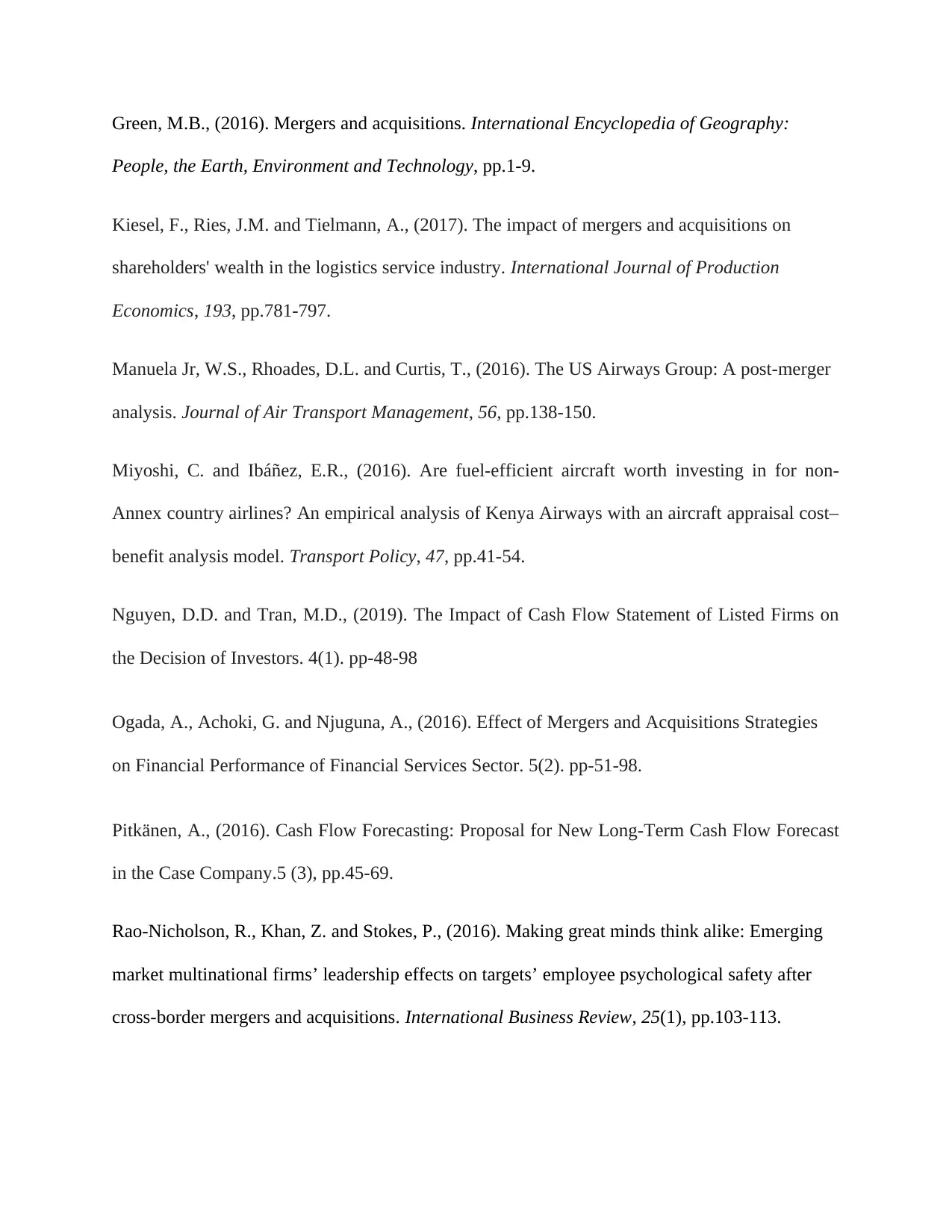
Green, M.B., (2016). Mergers and acquisitions. International Encyclopedia of Geography:
People, the Earth, Environment and Technology, pp.1-9.
Kiesel, F., Ries, J.M. and Tielmann, A., (2017). The impact of mergers and acquisitions on
shareholders' wealth in the logistics service industry. International Journal of Production
Economics, 193, pp.781-797.
Manuela Jr, W.S., Rhoades, D.L. and Curtis, T., (2016). The US Airways Group: A post-merger
analysis. Journal of Air Transport Management, 56, pp.138-150.
Miyoshi, C. and Ibáñez, E.R., (2016). Are fuel-efficient aircraft worth investing in for non-
Annex country airlines? An empirical analysis of Kenya Airways with an aircraft appraisal cost–
benefit analysis model. Transport Policy, 47, pp.41-54.
Nguyen, D.D. and Tran, M.D., (2019). The Impact of Cash Flow Statement of Listed Firms on
the Decision of Investors. 4(1). pp-48-98
Ogada, A., Achoki, G. and Njuguna, A., (2016). Effect of Mergers and Acquisitions Strategies
on Financial Performance of Financial Services Sector. 5(2). pp-51-98.
Pitkänen, A., (2016). Cash Flow Forecasting: Proposal for New Long-Term Cash Flow Forecast
in the Case Company.5 (3), pp.45-69.
Rao-Nicholson, R., Khan, Z. and Stokes, P., (2016). Making great minds think alike: Emerging
market multinational firms’ leadership effects on targets’ employee psychological safety after
cross-border mergers and acquisitions. International Business Review, 25(1), pp.103-113.
People, the Earth, Environment and Technology, pp.1-9.
Kiesel, F., Ries, J.M. and Tielmann, A., (2017). The impact of mergers and acquisitions on
shareholders' wealth in the logistics service industry. International Journal of Production
Economics, 193, pp.781-797.
Manuela Jr, W.S., Rhoades, D.L. and Curtis, T., (2016). The US Airways Group: A post-merger
analysis. Journal of Air Transport Management, 56, pp.138-150.
Miyoshi, C. and Ibáñez, E.R., (2016). Are fuel-efficient aircraft worth investing in for non-
Annex country airlines? An empirical analysis of Kenya Airways with an aircraft appraisal cost–
benefit analysis model. Transport Policy, 47, pp.41-54.
Nguyen, D.D. and Tran, M.D., (2019). The Impact of Cash Flow Statement of Listed Firms on
the Decision of Investors. 4(1). pp-48-98
Ogada, A., Achoki, G. and Njuguna, A., (2016). Effect of Mergers and Acquisitions Strategies
on Financial Performance of Financial Services Sector. 5(2). pp-51-98.
Pitkänen, A., (2016). Cash Flow Forecasting: Proposal for New Long-Term Cash Flow Forecast
in the Case Company.5 (3), pp.45-69.
Rao-Nicholson, R., Khan, Z. and Stokes, P., (2016). Making great minds think alike: Emerging
market multinational firms’ leadership effects on targets’ employee psychological safety after
cross-border mergers and acquisitions. International Business Review, 25(1), pp.103-113.
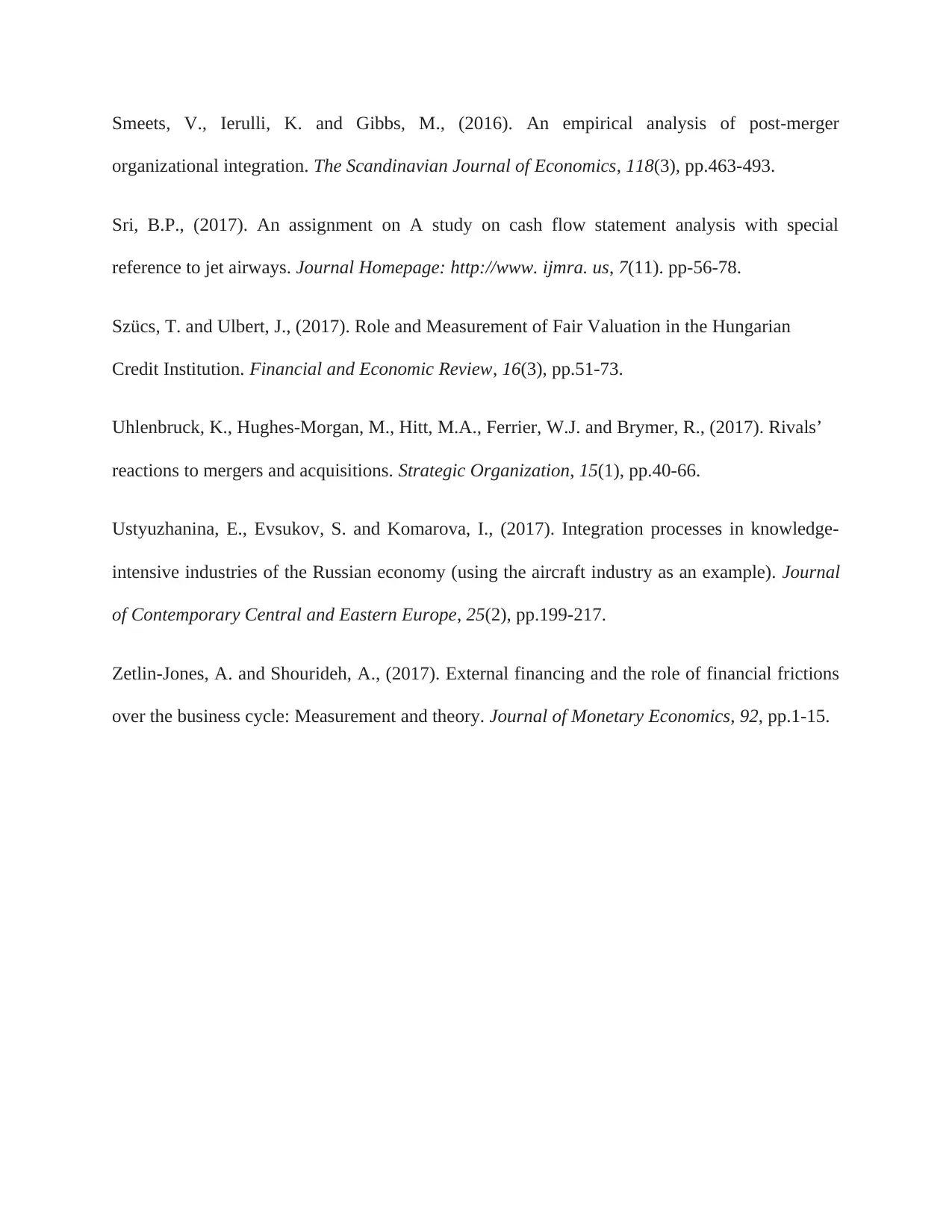
Smeets, V., Ierulli, K. and Gibbs, M., (2016). An empirical analysis of post‐merger
organizational integration. The Scandinavian Journal of Economics, 118(3), pp.463-493.
Sri, B.P., (2017). An assignment on A study on cash flow statement analysis with special
reference to jet airways. Journal Homepage: http://www. ijmra. us, 7(11). pp-56-78.
Szücs, T. and Ulbert, J., (2017). Role and Measurement of Fair Valuation in the Hungarian
Credit Institution. Financial and Economic Review, 16(3), pp.51-73.
Uhlenbruck, K., Hughes-Morgan, M., Hitt, M.A., Ferrier, W.J. and Brymer, R., (2017). Rivals’
reactions to mergers and acquisitions. Strategic Organization, 15(1), pp.40-66.
Ustyuzhanina, E., Evsukov, S. and Komarova, I., (2017). Integration processes in knowledge-
intensive industries of the Russian economy (using the aircraft industry as an example). Journal
of Contemporary Central and Eastern Europe, 25(2), pp.199-217.
Zetlin-Jones, A. and Shourideh, A., (2017). External financing and the role of financial frictions
over the business cycle: Measurement and theory. Journal of Monetary Economics, 92, pp.1-15.
organizational integration. The Scandinavian Journal of Economics, 118(3), pp.463-493.
Sri, B.P., (2017). An assignment on A study on cash flow statement analysis with special
reference to jet airways. Journal Homepage: http://www. ijmra. us, 7(11). pp-56-78.
Szücs, T. and Ulbert, J., (2017). Role and Measurement of Fair Valuation in the Hungarian
Credit Institution. Financial and Economic Review, 16(3), pp.51-73.
Uhlenbruck, K., Hughes-Morgan, M., Hitt, M.A., Ferrier, W.J. and Brymer, R., (2017). Rivals’
reactions to mergers and acquisitions. Strategic Organization, 15(1), pp.40-66.
Ustyuzhanina, E., Evsukov, S. and Komarova, I., (2017). Integration processes in knowledge-
intensive industries of the Russian economy (using the aircraft industry as an example). Journal
of Contemporary Central and Eastern Europe, 25(2), pp.199-217.
Zetlin-Jones, A. and Shourideh, A., (2017). External financing and the role of financial frictions
over the business cycle: Measurement and theory. Journal of Monetary Economics, 92, pp.1-15.
1 out of 25
Related Documents
Your All-in-One AI-Powered Toolkit for Academic Success.
+13062052269
info@desklib.com
Available 24*7 on WhatsApp / Email
![[object Object]](/_next/static/media/star-bottom.7253800d.svg)
Unlock your academic potential
© 2024 | Zucol Services PVT LTD | All rights reserved.




